2、Gateway和VirtualService原理分析
Gateway和VirtualService原理分析
目录
[toc]
本节实战
| 实战名称 |
|---|
分析 Gateway 和 VirtualService
前面我们创建了一个 Gateway 和 VirtualService 对象,用来对外暴露应用,然后我们就可以通过 ingressgateway 来访问 Bookinfo 应用了。那么这两个资源对象是如何实现的呢?
Gateway 资源是用来配置允许外部流量进入 Istio 服务网格的流量入口,用于接收传入的 HTTP/TCP 连接。它会配置暴露的端口、协议等,但与 Kubernetes Ingress 资源不同,不会包括任何流量路由配置,真正的路由规则是通过 VirtualService 来配置的。
🍀
我们再查看一下前面创建的 Gateway 对象的定义:
# samples/bookinfo/networking/bookinfo-gateway.yaml
apiVersion: networking.istio.io/v1alpha3
kind: Gateway
metadata:
name: bookinfo-gateway
spec:
selector: # 如果使用的是 Helm 方式安装,则默认应该是 istio=ingress 标签
istio: ingressgateway # 匹配 ingress gateway pod 的标签(kubectl get pods -l istio=ingressgateway -n istio-system)
servers:
- port:
number: 8080
name: http
protocol: HTTP
hosts:
- "*"
这里定义的 Gateway 对象中有一个 selector 标签选择器,它会匹配 istio=ingressgateway 标签的 Pod,其实就是 istio-ingressgateway 这个组件。
[root@master1 ~]#kubectl get po -nistio-system
NAME READY STATUS RESTARTS AGE
istio-egressgateway-8477dd44c4-jgpcg 1/1 Running 0 12h
istio-ingressgateway-5c58fcb646-df7rz 1/1 Running 0 12h
istiod-5d9595449c-8tt97 1/1 Running 0 12h
[root@master1 ~]#kubectl get po -l istio=ingressgateway -nistio-system
NAME READY STATUS RESTARTS AGE
istio-ingressgateway-5c58fcb646-df7rz 1/1 Running 0 12h
# samples/bookinfo/networking/bookinfo-gateway.yaml
apiVersion: networking.istio.io/v1alpha3
kind: Gateway
metadata:
name: bookinfo-gateway
spec:
selector: # 如果使用的是 Helm 方式安装,则默认应该是 istio=ingress 标签
istio: ingressgateway # 匹配 ingress gateway pod 的标签(kubectl get pods -l istio=ingressgateway -n istio-system)
servers:
- port:
number: 8080
name: http
protocol: HTTP
hosts:
- "*"
---
apiVersion: networking.istio.io/v1alpha3
kind: VirtualService
metadata:
name: bookinfo
spec:
hosts:
- "*"
gateways:
- bookinfo-gateway
http:
- match:
- uri:
exact: /productpage
- uri:
prefix: /static
- uri:
exact: /login
- uri:
exact: /logout
- uri:
prefix: /api/v1/products
route:
- destination:
host: productpage
port:
number: 9080
🍀
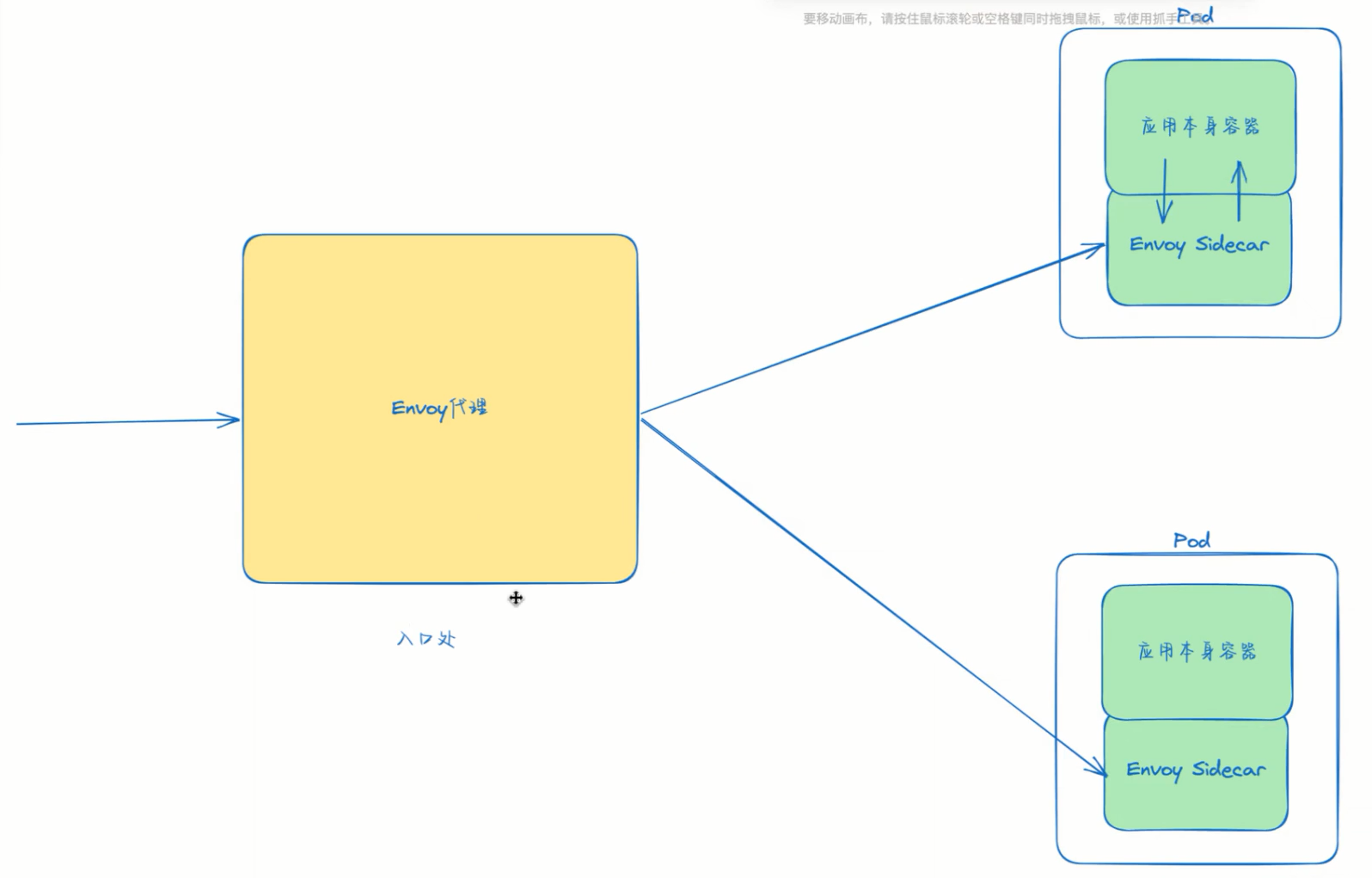
其实本质上 istio-ingressgateway 也是一个 Envoy 代理,用来作为 Istio 的统一入口网关,它会接收外部流量,然后根据 VirtualService 中定义的路由规则来进行流量的转发。
我们可以查看下 istio-ingressgateway 的 Envoy 配置来验证下:
# 进入 ingressgateway 组件所在的 Pod 中
$ kubectl exec -it istio-ingressgateway-9c8b9b586-s6s48 -n istio-system -- /bin/bash
istio-proxy@istio-ingressgateway-9c8b9b586-s6s48:/$ ll /etc/istio/proxy
total 20
drwxrwsrwx 2 root istio-proxy 66 Nov 3 02:16 ./
drwxr-xr-x 7 root root 103 Nov 3 02:16 ../
srw-rw-rw- 1 istio-proxy istio-proxy 0 Nov 3 02:16 XDS=
-rw-r--r-- 1 istio-proxy istio-proxy 14130 Nov 3 02:16 envoy-rev.json
-rw-r--r-- 1 istio-proxy istio-proxy 2699 Nov 3 02:16 grpc-bootstrap.json
istio-proxy@istio-ingressgateway-9c8b9b586-s6s48:/$
在 istio-ingressgateway 组件的 Pod 目录中有一个配置文件 envoy-rev.json,这个文件就是 Envoy 的配置文件,但是由于这里采用的是 xDS 动态配置的方式,所以直接看不到前面我们添加的 Gateway 相关信息的。
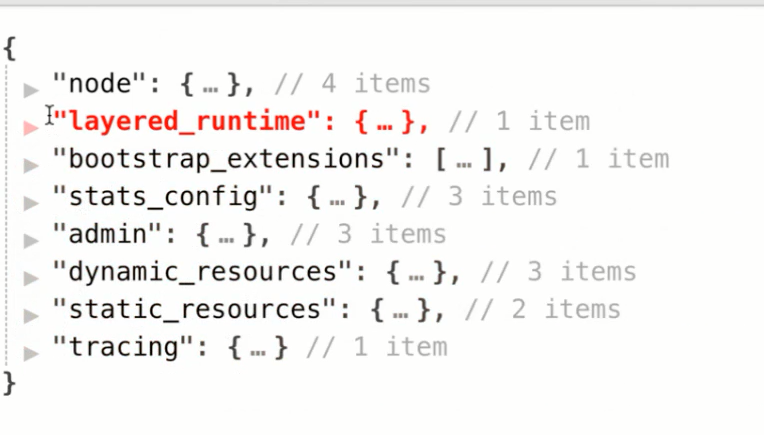
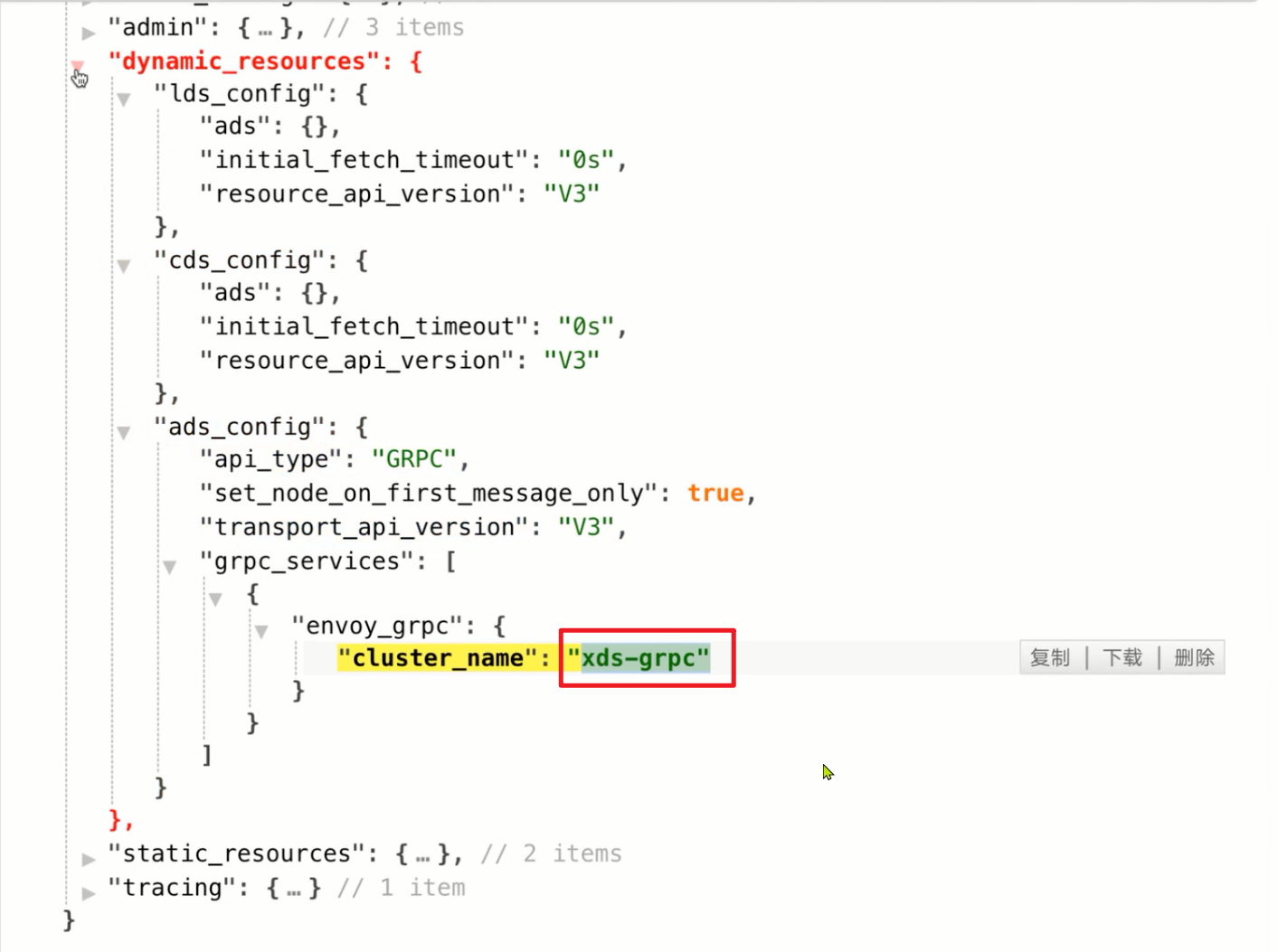
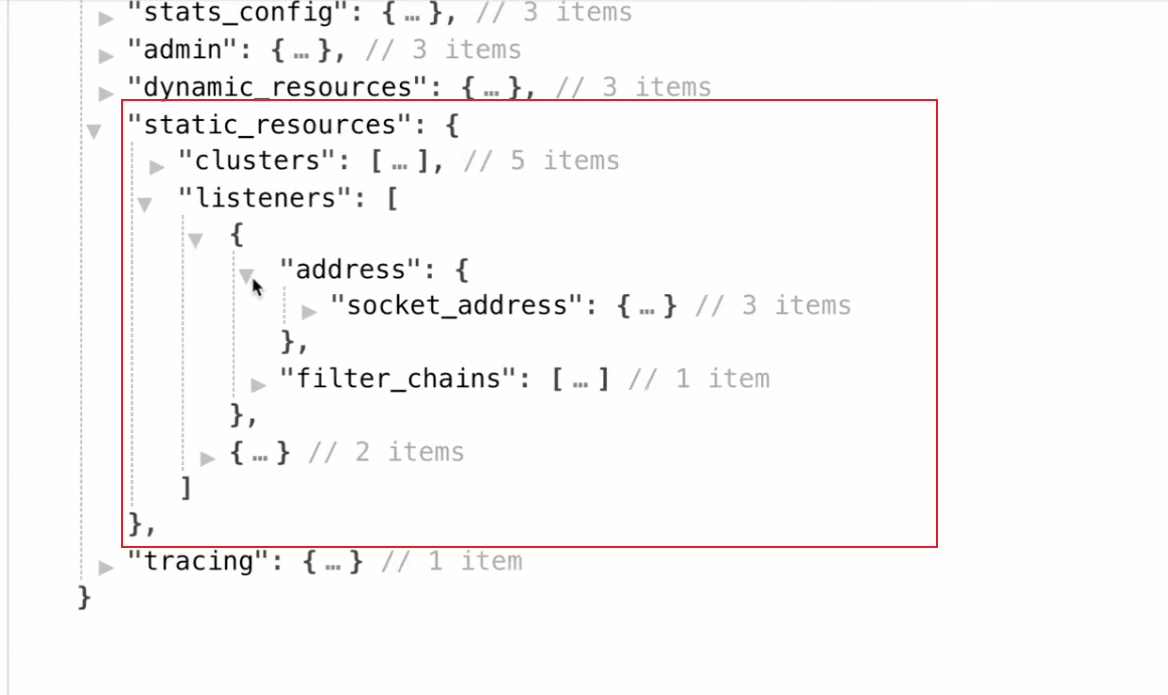
静态的2个配置:
1.数据采集
2.监控检查
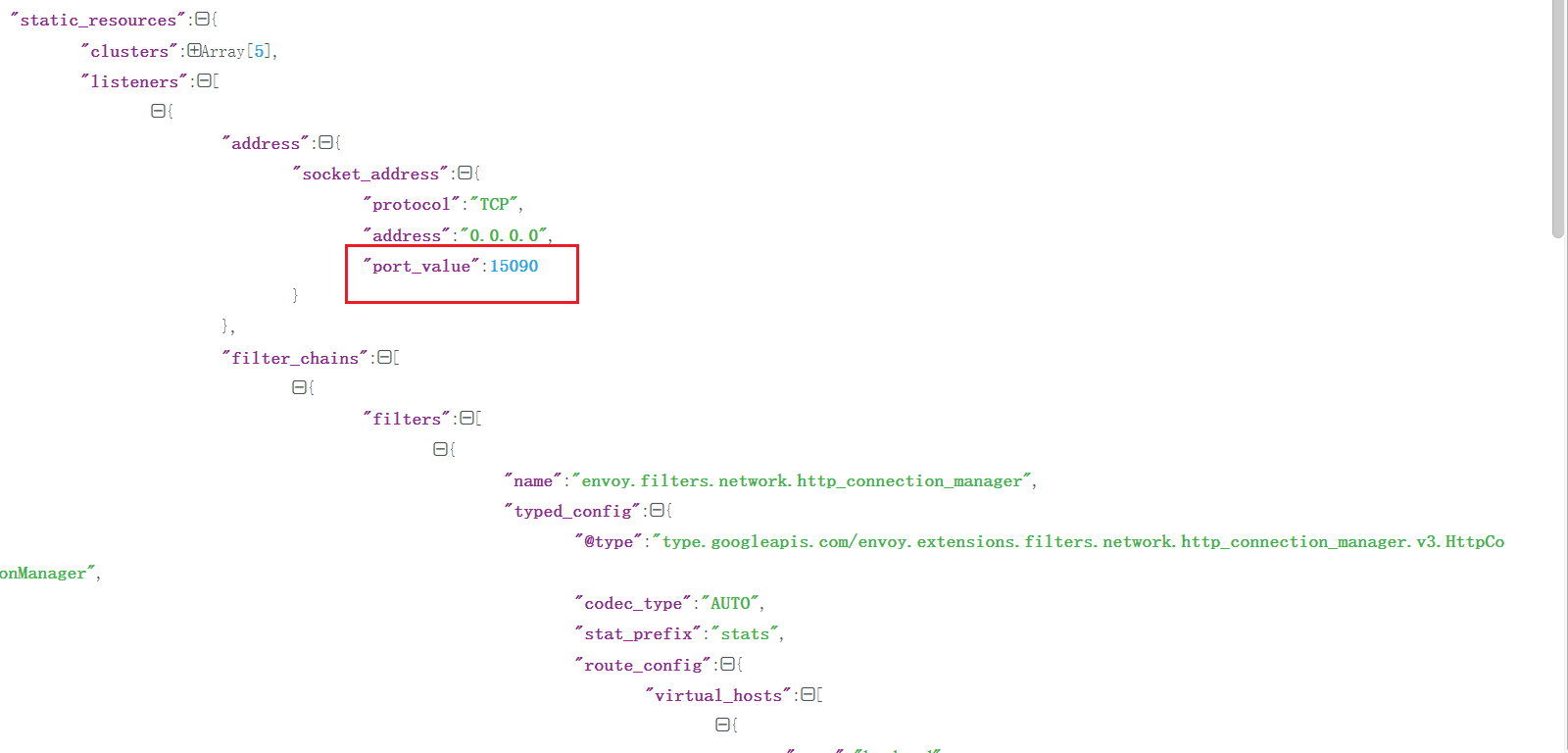
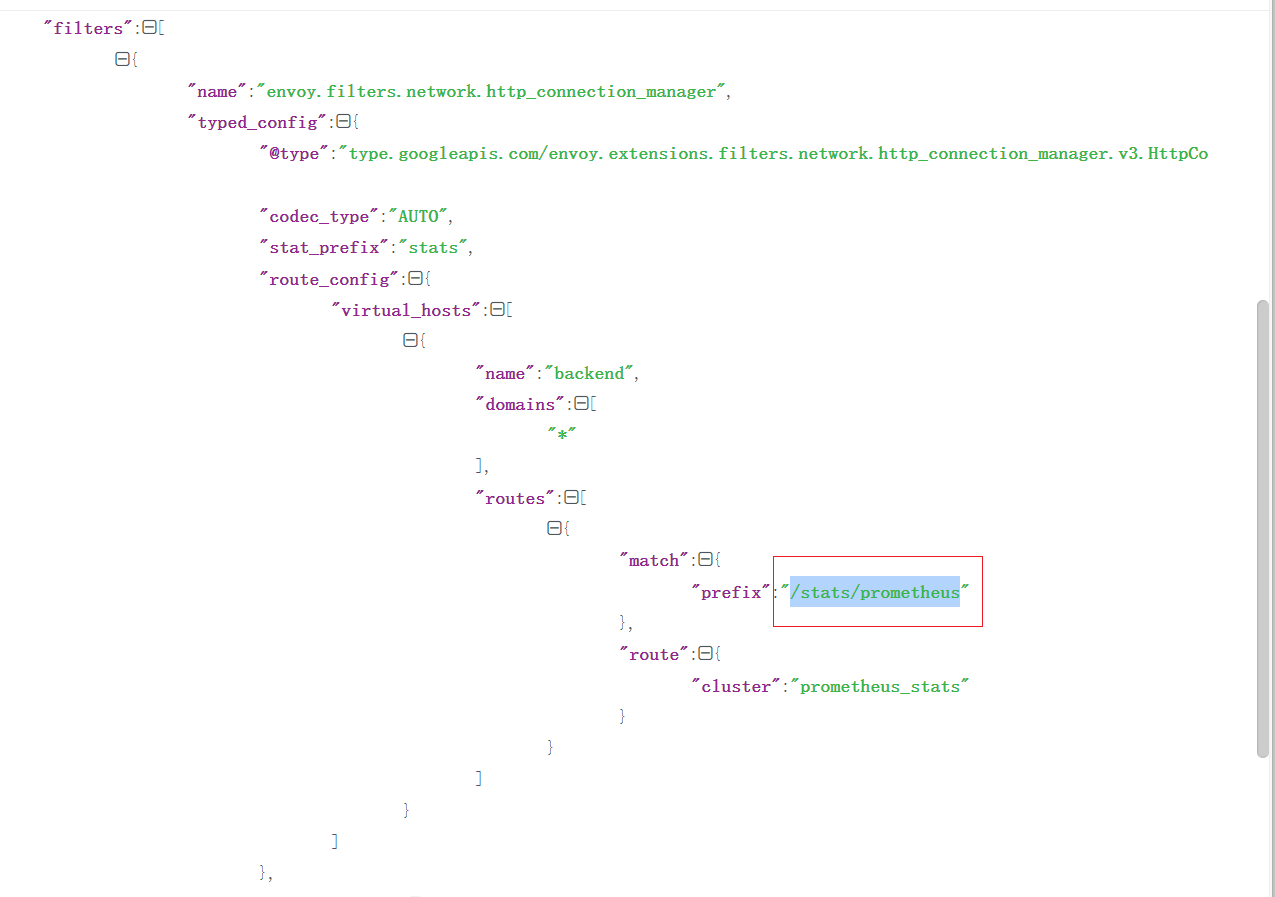
[root@master1 ~]#kubectl get po -nistio-system -owide
NAME READY STATUS RESTARTS AGE IP NODE NOMINATED NODE READINESS GATES
grafana-86b7d46c86-zphx2 1/1 Running 0 4h38m 10.244.2.15 node1 <none> <none>
istio-egressgateway-8477dd44c4-jgpcg 1/1 Running 0 18h 10.244.1.18 node2 <none> <none>
istio-ingressgateway-5c58fcb646-df7rz 1/1 Running 0 18h 10.244.1.19 node2 <none> <none>
istiod-5d9595449c-8tt97 1/1 Running 0 18h 10.244.1.17 node2 <none> <none>
jaeger-594658fc5b-789s6 1/1 Running 0 4h38m 10.244.2.16 node1 <none> <none>
kiali-6ff88d695b-2rwtk 1/1 Running 0 4h38m 10.244.1.25 node2 <none> <none>
prometheus-67599c8d5c-gdhv9 2/2 Running 0 4h38m 10.244.2.17 node1 <none> <none>
[root@master1 ~]#curl 10.244.1.19:15090/stats/prometheus
……
# TYPE envoy_server_initialization_time_ms histogram
envoy_server_initialization_time_ms_bucket{le="0.5"} 0
envoy_server_initialization_time_ms_bucket{le="1"} 0
envoy_server_initialization_time_ms_bucket{le="5"} 0
envoy_server_initialization_time_ms_bucket{le="10"} 0
envoy_server_initialization_time_ms_bucket{le="25"} 0
envoy_server_initialization_time_ms_bucket{le="50"} 0
envoy_server_initialization_time_ms_bucket{le="100"} 0
envoy_server_initialization_time_ms_bucket{le="250"} 1
envoy_server_initialization_time_ms_bucket{le="500"} 1
envoy_server_initialization_time_ms_bucket{le="1000"} 1
envoy_server_initialization_time_ms_bucket{le="2500"} 1
envoy_server_initialization_time_ms_bucket{le="5000"} 1
envoy_server_initialization_time_ms_bucket{le="10000"} 1
envoy_server_initialization_time_ms_bucket{le="30000"} 1
envoy_server_initialization_time_ms_bucket{le="60000"} 1
envoy_server_initialization_time_ms_bucket{le="300000"} 1
envoy_server_initialization_time_ms_bucket{le="600000"} 1
envoy_server_initialization_time_ms_bucket{le="1800000"} 1
envoy_server_initialization_time_ms_bucket{le="3600000"} 1
envoy_server_initialization_time_ms_bucket{le="+Inf"} 1
envoy_server_initialization_time_ms_sum{} 125
envoy_server_initialization_time_ms_count{} 1
[root@master1 ~]#

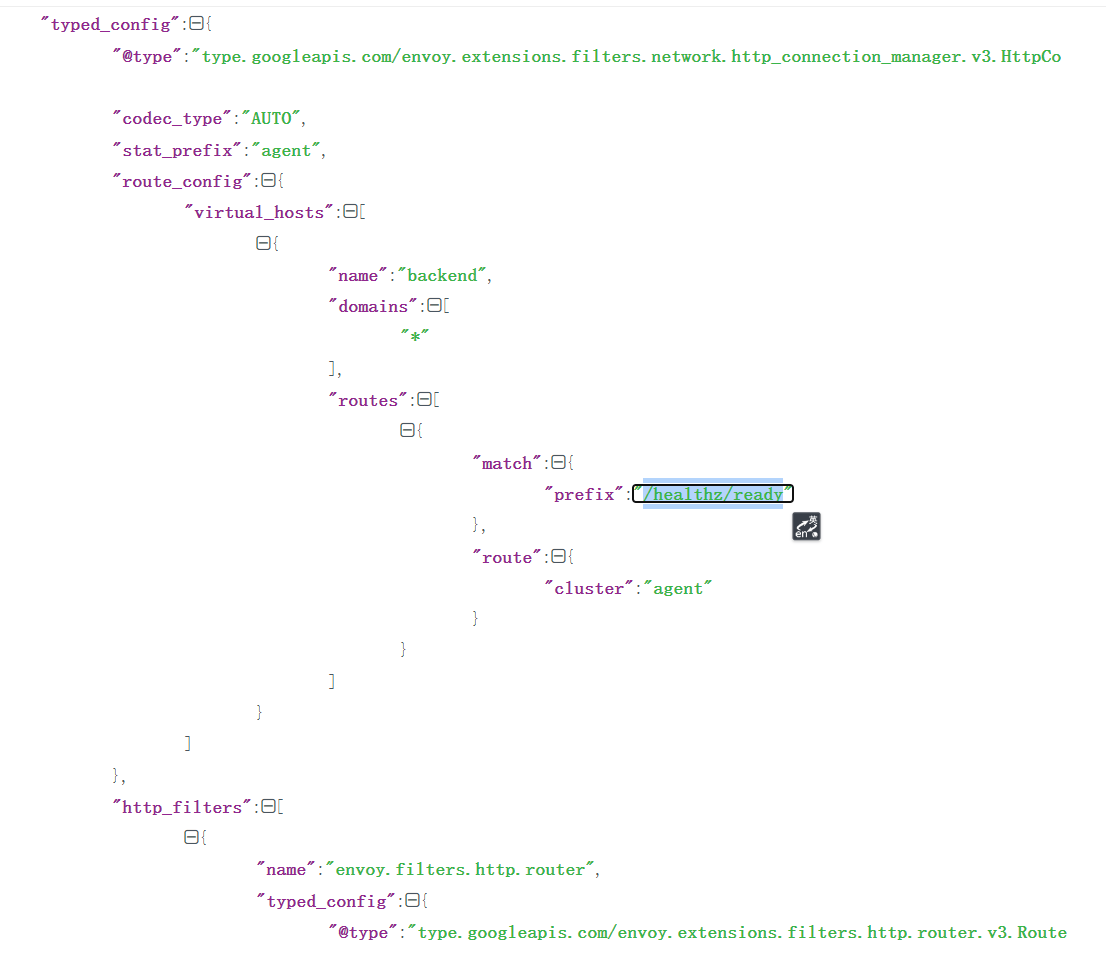
[root@master1 ~]#curl 10.244.1.19:15021/healthz/ready
[root@master1 ~]#curl 10.244.1.19:15021/healthz/ready
[root@master1 ~]#
[root@master1 ~]#kubectl get deploy istio-ingressgateway -nistio-system -oyaml
……
readinessProbe:
failureThreshold: 30
httpGet:
path: /healthz/ready
port: 15021
scheme: HTTP
initialDelaySeconds: 1
periodSeconds: 2
successThreshold: 1
timeoutSeconds: 1
这2个就对的上了:
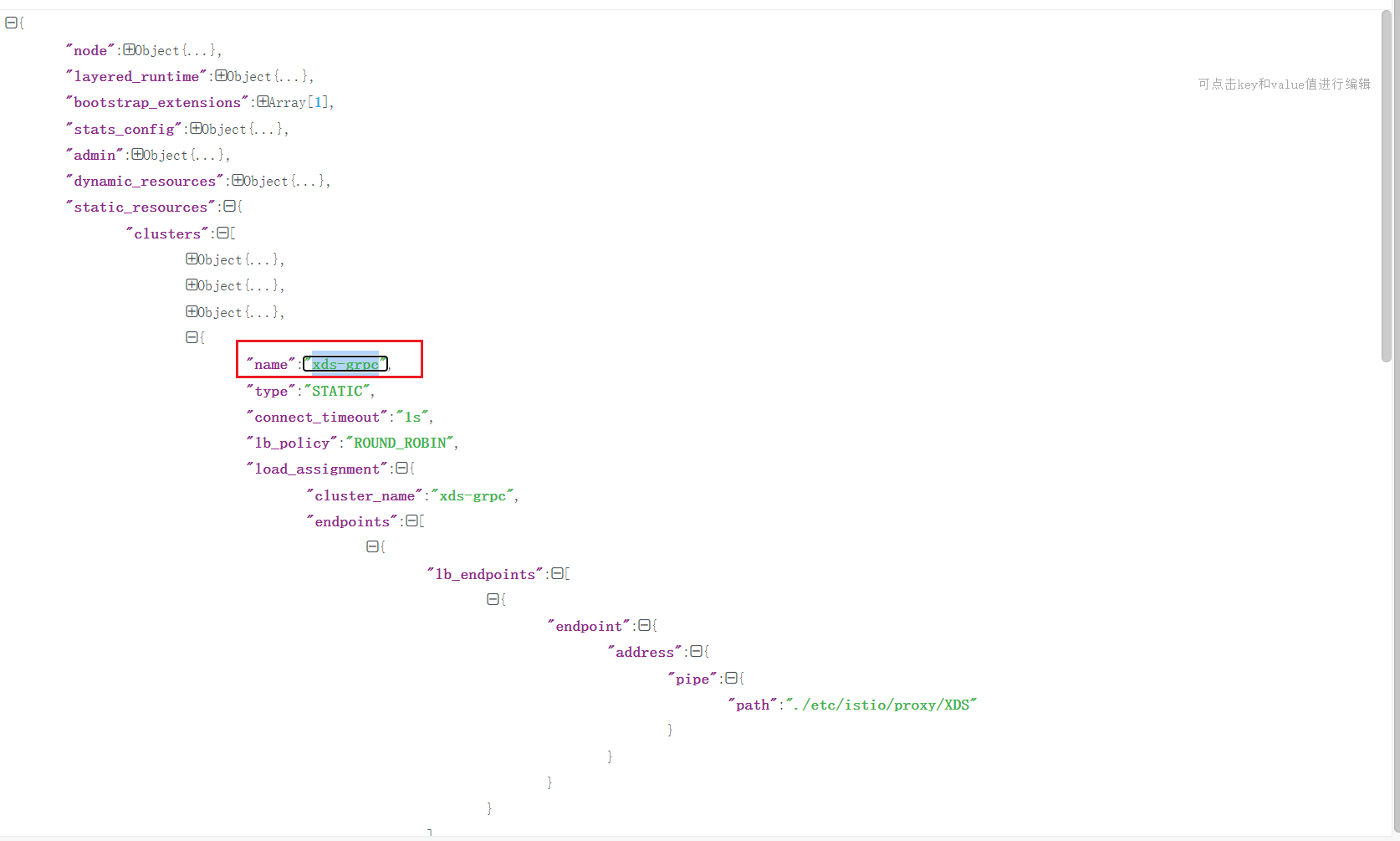
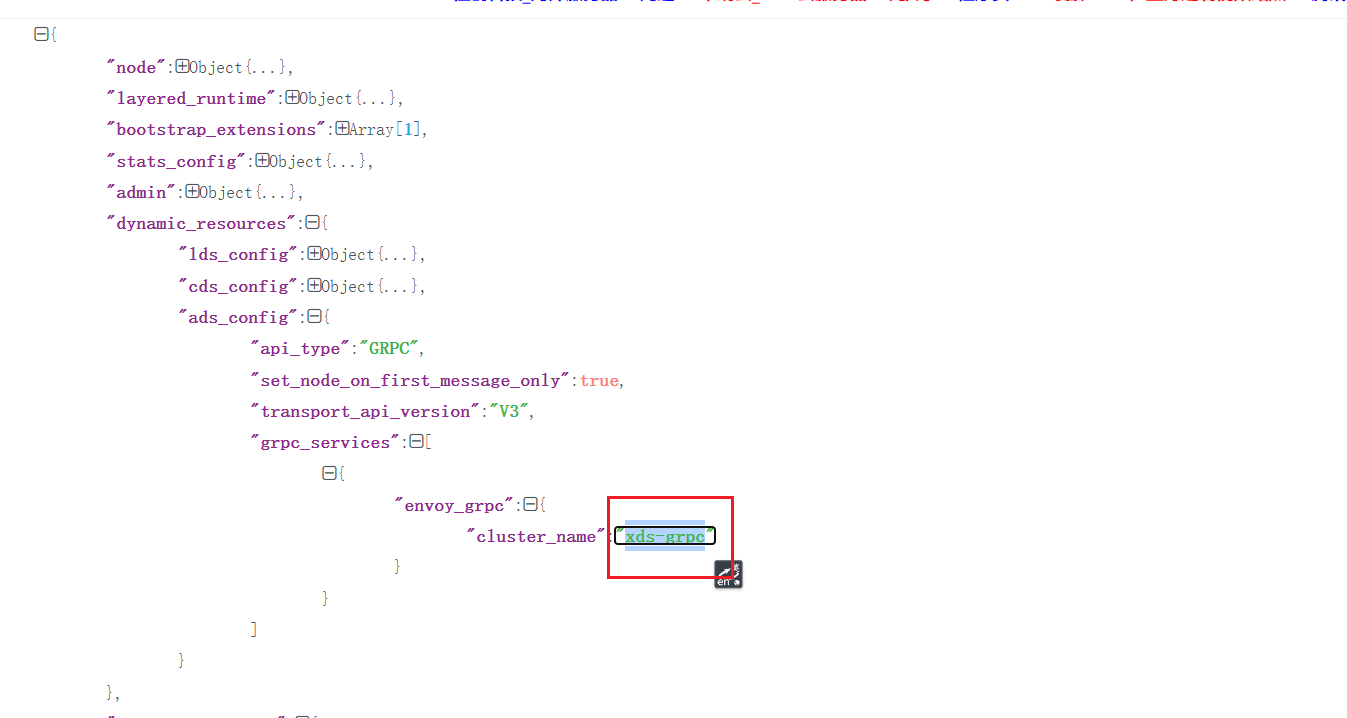

🍀
但是我们可以利用 Envoy 的 Admin 提供的 config_dump 来查看下配置文件:
kubectl exec istio-ingressgateway-9c8b9b586-s6s48 -c istio-proxy -n istio-system -- curl 'localhost:15000/config_dump' > ingressgateway_envoy_conf.json
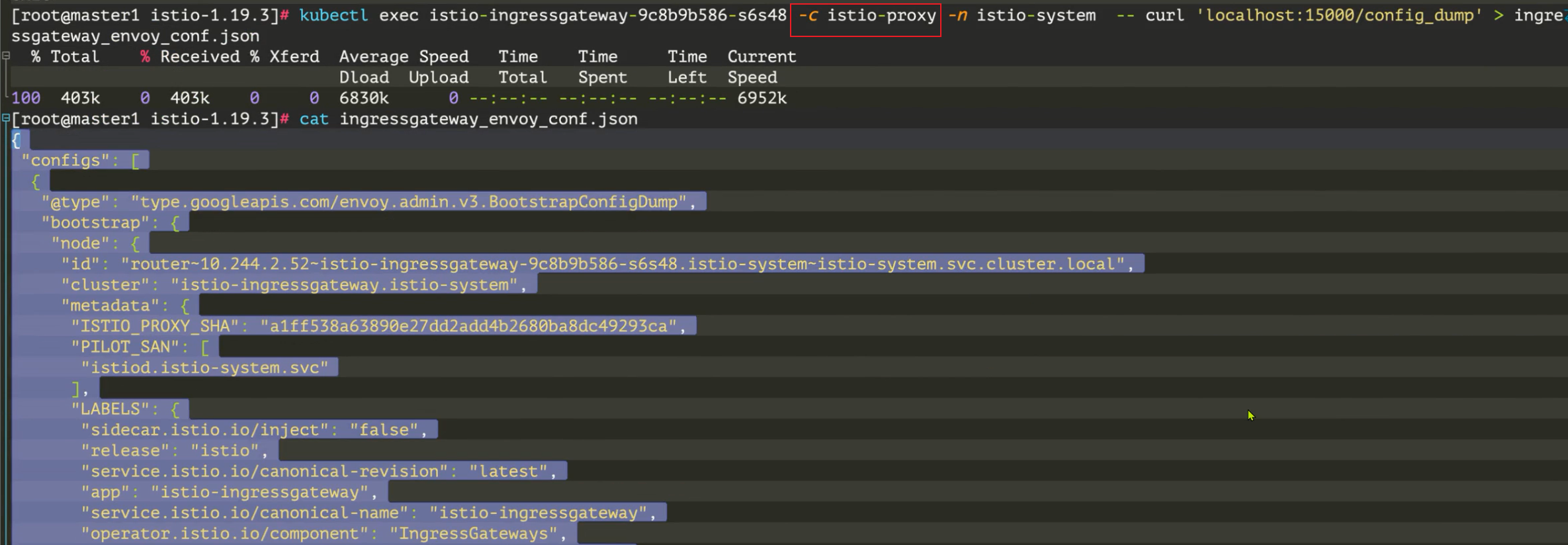
istio envoy 默认配置为 json 格式,导出来的配置文件非常长(==有 10000+行==),我们可以先只看上层内容:
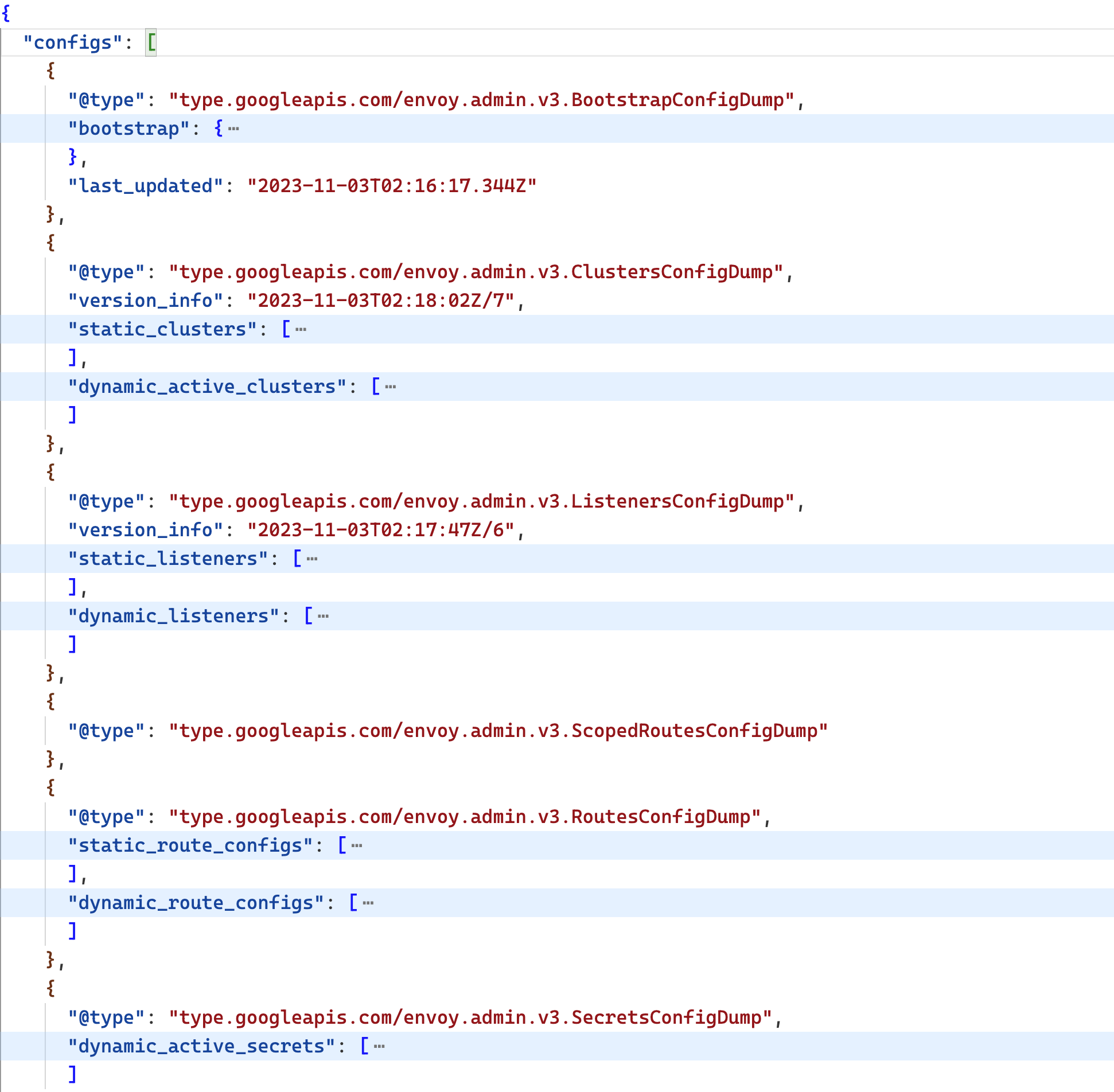
我们可以看到这个配置文件中其实就一个 configs 数组,每个元素都是一项配置,每个配置都指定了一个独特的 @type 字段,来指定该配置是是干嘛的。接下来我们就来看下这个配置文件中的每个配置项都是干嘛的。
BootStrapConfigDump
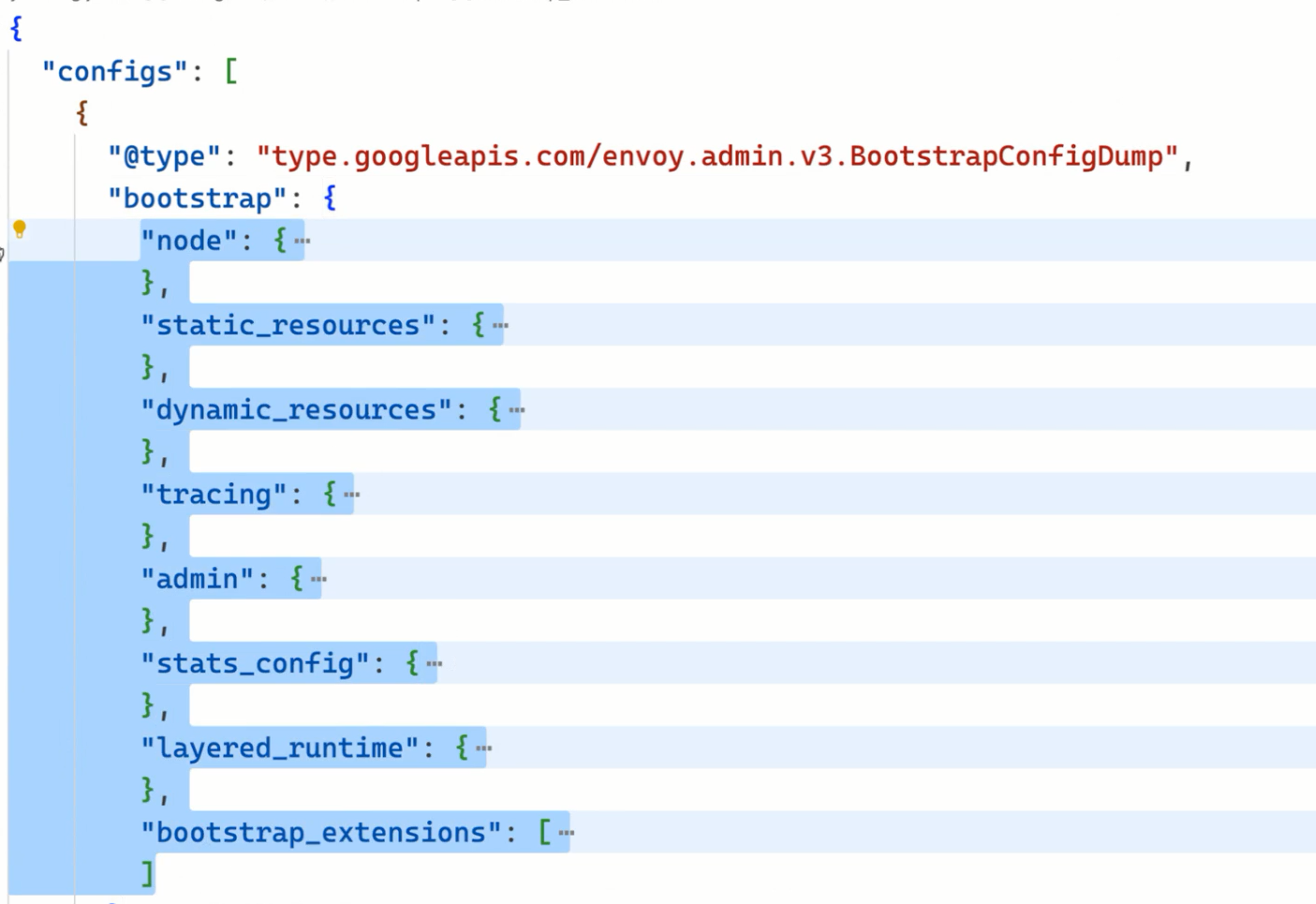
用于在 Envoy 启动时加载的一些静态配置,包括类似 Sidecar 的环境变量等信息。
我们也可以使用 istioctl proxy-config bootstrap 命令来查看这部分配置:
$ istioctl proxy-config bootstrap istio-ingressgateway-9c8b9b586-s6s48 -n istio-system -o yaml
bootstrap:
admin:
address:
socketAddress:
address: 127.0.0.1
portValue: 15000
profilePath: /var/lib/istio/data/envoy.prof
dynamicResources: # 动态配置发现服务信息
adsConfig:
apiType: GRPC
grpcServices:
- envoyGrpc:
clusterName: xds-grpc
setNodeOnFirstMessageOnly: true
transportApiVersion: V3
cdsConfig:
ads: {}
initialFetchTimeout: 0s
resourceApiVersion: V3
ldsConfig:
ads: {}
initialFetchTimeout: 0s
resourceApiVersion: V3
node: # 节点信息
cluster: istio-ingressgateway.istio-system
id: router~10.244.2.52~istio-ingressgateway-9c8b9b586-s6s48.istio-system~istio-system.svc.cluster.local
# ......
staticResources:
clusters:
- connectTimeout: 0.250s # prometheus cluster
loadAssignment:
clusterName: prometheus_stats
endpoints:
- lbEndpoints:
- endpoint:
address:
socketAddress:
address: 127.0.0.1
portValue: 15000
name: prometheus_stats
type: STATIC
- connectTimeout: 0.250s # agent cluster
loadAssignment:
clusterName: agent
endpoints:
- lbEndpoints:
- endpoint:
address:
socketAddress:
address: 127.0.0.1
portValue: 15020
name: agent
type: STATIC
- connectTimeout: 1s
loadAssignment:
clusterName: sds-grpc
endpoints:
- lbEndpoints:
- endpoint:
address:
pipe:
path: ./var/run/secrets/workload-spiffe-uds/socket
name: sds-grpc
type: STATIC
typedExtensionProtocolOptions:
envoy.extensions.upstreams.http.v3.HttpProtocolOptions:
'@type': type.googleapis.com/envoy.extensions.upstreams.http.v3.HttpProtocolOptions
explicitHttpConfig:
http2ProtocolOptions: {}
- circuitBreakers:
thresholds:
- maxConnections: 100000
maxPendingRequests: 100000
maxRequests: 100000
- maxConnections: 100000
maxPendingRequests: 100000
maxRequests: 100000
priority: HIGH
connectTimeout: 1s
loadAssignment: # xds-grpc cluster
clusterName: xds-grpc
endpoints:
- lbEndpoints:
- endpoint:
address:
pipe:
path: ./etc/istio/proxy/XDS
maxRequestsPerConnection: 1
name: xds-grpc
type: STATIC
typedExtensionProtocolOptions:
envoy.extensions.upstreams.http.v3.HttpProtocolOptions:
'@type': type.googleapis.com/envoy.extensions.upstreams.http.v3.HttpProtocolOptions
explicitHttpConfig:
http2ProtocolOptions: {}
upstreamConnectionOptions:
tcpKeepalive:
keepaliveTime: 300
- connectTimeout: 1s
dnsLookupFamily: V4_ONLY
dnsRefreshRate: 30s
loadAssignment: # zipkin cluster
clusterName: zipkin
endpoints:
- lbEndpoints:
- endpoint:
address:
socketAddress:
address: zipkin.istio-system
portValue: 9411
name: zipkin
respectDnsTtl: true
type: STRICT_DNS
listeners:
- address:
socketAddress:
address: 0.0.0.0
portValue: 15090 # prometheus listener
filterChains:
- filters:
- name: envoy.filters.network.http_connection_manager
typedConfig:
'@type': type.googleapis.com/envoy.extensions.filters.network.http_connection_manager.v3.HttpConnectionManager
httpFilters:
- name: envoy.filters.http.router
typedConfig:
'@type': type.googleapis.com/envoy.extensions.filters.http.router.v3.Router
routeConfig:
virtualHosts:
- domains:
- '*'
name: backend
routes:
- match:
prefix: /stats/prometheus
route:
cluster: prometheus_stats
statPrefix: stats
- address:
socketAddress:
address: 0.0.0.0
portValue: 15021 # agent listener(健康检查)
filterChains:
- filters:
- name: envoy.filters.network.http_connection_manager
typedConfig:
'@type': type.googleapis.com/envoy.extensions.filters.network.http_connection_manager.v3.HttpConnectionManager
httpFilters:
- name: envoy.filters.http.router
typedConfig:
'@type': type.googleapis.com/envoy.extensions.filters.http.router.v3.Router
routeConfig:
virtualHosts:
- domains:
- '*'
name: backend
routes:
- match:
prefix: /healthz/ready
route:
cluster: agent
statPrefix: agent
statsConfig:
# ......
tracing: # 链路追踪
http:
name: envoy.tracers.zipkin
typedConfig:
'@type': type.googleapis.com/envoy.config.trace.v3.ZipkinConfig
collectorCluster: zipkin
collectorEndpoint: /api/v2/spans
collectorEndpointVersion: HTTP_JSON
sharedSpanContext: false
traceId128bit: true
上面的配置和之前我们介绍的 Envoy 配置基本一致,在上面配置中定义了一个 Prometheus 监听器,用来暴露 Prometheus 监控指标,还定义了一个 Agent 监听器,用来暴露健康检查接口,另外还定义了一个 zipkin 集群,用来定义链路追踪的配置。另外通过 dynamicResources 定义了动态配置发现服务信息,xds-grpc 就是用来定义 Envoy 与 Pilot 之间的 xDS 通信的。
ListenersConfigDump
这里存储着 Envoy 的 listeners 配置,也就是 Envoy 的监听器。Envoy 在拦截到请求后,会根据请求的地址与端口,将请求交给匹配的 listener 处理。
我们看到这个 ListenersConfigDump 中的 listener 配置分成了 static_listners 和 dynamic_listeners,分别对应 Envoy 的静态配置和动态配置,静态配置,是 Envoy 配置文件中直接指定的,而 dynamic_listeners的 listener 则是 istiod 通过 xDS 协议为 Envoy 下发的。
同样我们也可以使用 istioctl proxy-config listener 命令来查看这部分配置:
istioctl proxy-config listener istio-ingressgateway-9c8b9b586-s6s48 -n istio-system -o yaml
对应的配置文件如下所示:
- accessLog:
- filter:
responseFlagFilter:
flags:
- NR
name: envoy.access_loggers.file
typedConfig:
"@type": type.googleapis.com/envoy.extensions.access_loggers.file.v3.FileAccessLog
logFormat:
textFormatSource:
inlineString: |
[%START_TIME%] "%REQ(:METHOD)% %REQ(X-ENVOY-ORIGINAL-PATH?:PATH)% %PROTOCOL%" %RESPONSE_CODE% %RESPONSE_FLAGS% %RESPONSE_CODE_DETAILS% %CONNECTION_TERMINATION_DETAILS% "%UPSTREAM_TRANSPORT_FAILURE_REASON%" %BYTES_RECEIVED% %BYTES_SENT% %DURATION% %RESP(X-ENVOY-UPSTREAM-SERVICE-TIME)% "%REQ(X-FORWARDED-FOR)%" "%REQ(USER-AGENT)%" "%REQ(X-REQUEST-ID)%" "%REQ(:AUTHORITY)%" "%UPSTREAM_HOST%" %UPSTREAM_CLUSTER% %UPSTREAM_LOCAL_ADDRESS% %DOWNSTREAM_LOCAL_ADDRESS% %DOWNSTREAM_REMOTE_ADDRESS% %REQUESTED_SERVER_NAME% %ROUTE_NAME%
path: /dev/stdout
address:
socketAddress:
address: 0.0.0.0
portValue: 8080
continueOnListenerFiltersTimeout: true
filterChains:
- filters:
- name: istio_authn
typedConfig:
"@type": type.googleapis.com/udpa.type.v1.TypedStruct
typeUrl: type.googleapis.com/io.istio.network.authn.Config
- name: envoy.filters.network.http_connection_manager
typedConfig:
"@type": type.googleapis.com/envoy.extensions.filters.network.http_connection_manager.v3.HttpConnectionManager
accessLog:
- name: envoy.access_loggers.file
typedConfig:
"@type": type.googleapis.com/envoy.extensions.access_loggers.file.v3.FileAccessLog
logFormat:
textFormatSource:
inlineString: |
[%START_TIME%] "%REQ(:METHOD)% %REQ(X-ENVOY-ORIGINAL-PATH?:PATH)% %PROTOCOL%" %RESPONSE_CODE% %RESPONSE_FLAGS% %RESPONSE_CODE_DETAILS% %CONNECTION_TERMINATION_DETAILS% "%UPSTREAM_TRANSPORT_FAILURE_REASON%" %BYTES_RECEIVED% %BYTES_SENT% %DURATION% %RESP(X-ENVOY-UPSTREAM-SERVICE-TIME)% "%REQ(X-FORWARDED-FOR)%" "%REQ(USER-AGENT)%" "%REQ(X-REQUEST-ID)%" "%REQ(:AUTHORITY)%" "%UPSTREAM_HOST%" %UPSTREAM_CLUSTER% %UPSTREAM_LOCAL_ADDRESS% %DOWNSTREAM_LOCAL_ADDRESS% %DOWNSTREAM_REMOTE_ADDRESS% %REQUESTED_SERVER_NAME% %ROUTE_NAME%
path: /dev/stdout
forwardClientCertDetails: SANITIZE_SET
httpFilters:
- name: istio.metadata_exchange
typedConfig:
"@type": type.googleapis.com/udpa.type.v1.TypedStruct
typeUrl: type.googleapis.com/io.istio.http.peer_metadata.Config
value:
upstream_discovery:
- istio_headers: {}
- workload_discovery: {}
upstream_propagation:
- istio_headers: {}
- name: envoy.filters.http.grpc_stats
typedConfig:
"@type": type.googleapis.com/envoy.extensions.filters.http.grpc_stats.v3.FilterConfig
emitFilterState: true
statsForAllMethods: false
- name: istio.alpn
typedConfig:
"@type": type.googleapis.com/istio.envoy.config.filter.http.alpn.v2alpha1.FilterConfig
alpnOverride:
- alpnOverride:
- istio-http/1.0
- istio
- http/1.0
- alpnOverride:
- istio-http/1.1
- istio
- http/1.1
upstreamProtocol: HTTP11
- alpnOverride:
- istio-h2
- istio
- h2
upstreamProtocol: HTTP2
- name: envoy.filters.http.fault
typedConfig:
"@type": type.googleapis.com/envoy.extensions.filters.http.fault.v3.HTTPFault
- name: envoy.filters.http.cors
typedConfig:
"@type": type.googleapis.com/envoy.extensions.filters.http.cors.v3.Cors
- name: istio.stats
typedConfig:
"@type": type.googleapis.com/stats.PluginConfig
disableHostHeaderFallback: true
- name: envoy.filters.http.router
typedConfig:
"@type": type.googleapis.com/envoy.extensions.filters.http.router.v3.Router
httpProtocolOptions: {}
normalizePath: true
pathWithEscapedSlashesAction: KEEP_UNCHANGED
rds:
configSource:
ads: {}
initialFetchTimeout: 0s
resourceApiVersion: V3
routeConfigName: http.8080
requestIdExtension:k
typedConfig:
"@type": type.googleapis.com/envoy.extensions.request_id.uuid.v3.UuidRequestIdConfig
useRequestIdForTraceSampling: true
serverName: istio-envoy
setCurrentClientCertDetails:
cert: true
dns: true
subject: true
uri: true
statPrefix: outbound_0.0.0.0_8080
streamIdleTimeout: 0s
tracing:
# ......
upgradeConfigs:
- upgradeType: websocket
useRemoteAddress: true
name: 0.0.0.0_8080
trafficDirection: OUTBOUND
- address:
socketAddress:
address: 0.0.0.0
portValue: 15090
# ......
- address:
socketAddress:
address: 0.0.0.0
portValue: 15021
# ......
虽然上面看到的 listener 配置还是很长,但是我们应该也还是非常熟悉的,本质就是 Envoy 的配置文件中的 listener 配置。我们这里重点看下动态配置对应的配置,静态的就是前面指定 prometheus 和 agent 对应的监听器配置。
我们可以看到上面的动态配置对应的监听器名称为 0.0.0.0_8080,对应的监听地址为 0.0.0.0:8080,也就是说在 Envoy 中监听了 8080 端口:
address:
socketAddress:
address: 0.0.0.0
portValue: 8080
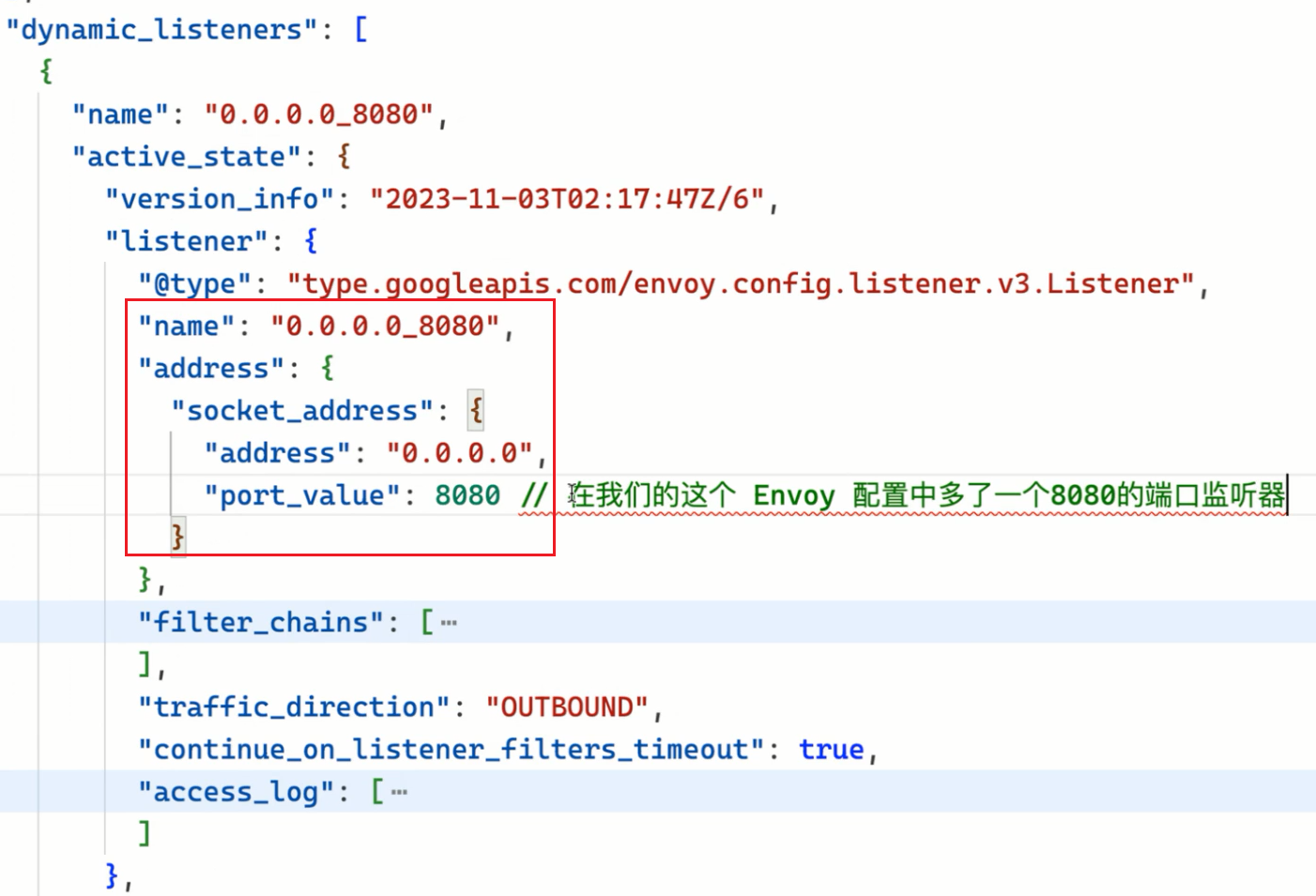
而前面我们是不是创建了一个 Gateway 资源对象,并指定了 8080 端口,其实这个端口就是我们前面创建的 Gateway 对象中定义的端口,这个监听器的配置就是通过 istiod 通过 xDS 协议下发的。
那么请求是如何到达这个监听器的呢?我们可以查看下 istio-ingressgateway 组建的 Service 数�据:
$ kubectl get svc istio-ingressgateway -n istio-system
NAME TYPE CLUSTER-IP EXTERNAL-IP PORT(S) AGE
istio-ingressgateway LoadBalancer 10.103.227.57 <pending> 15021:32459/TCP,80:31896/TCP,443:30808/TCP,31400:31535/TCP,15443:30761/TCP 46h
我们可以看到 istio-ingressgateway 组件的 Service 中定义了 5 个端口,还记得前面我们去访问 Productpage 的时候是如何访问的吗?是不是通过 http://$GATEWAY_URL/productpage 访问的,而我们这里没有 LoadBalancer,所以直接使用 NodePort 形式访问就行,最终我们是通过 http://NodeIP:31896/productpage 来访问应用的,而这个 31896 端口对应 istio-ingressgateway 组件的 Service 中定义的 80 端口,也就是说我们的请求是通过 80 端口到达 istio-ingressgateway 组件的,那么这个 80 端口是如何到达 istio-ingressgateway 组件的呢?
$ kubectl describe svc istio-ingressgateway -n istio-system
Name: istio-ingressgateway
Namespace: istio-system
# ......
Port: http2 80/TCP
TargetPort: 8080/TCP
NodePort: http2 31896/TCP
Endpoints: 10.244.2.52:8080
我们查看 Service 的定义就明白了,实际上 istio-ingressgateway 这个 Service 定义的 80 端口对应的是 istio-ingressgateway 组件 Pod 的 8080 端口,也就是说我们的请求是通过 80 端口到达 istio-ingressgateway 组件的 8080 端口的,而这个 8080 端口就是我们前面在 Envoy 配置中看到的监听器的端口了,所以当我们访问 http://$GATEWAY_URL/productpage 的时候请求到达了 istio-ingressgateway 这个组件的 8080 端口了。
当请求到达 istio-ingressgateway 组件时,就会被这个监听器所匹配,然后将请求交给 http_connection_manager 这个 filter 来处理,当然后面就是用各种具体的 filter 来处理请求了,比如 envoy.filters.http.fault 这个 filter 就是用来处理故障注入的,envoy.filters.http.router 则是用来处理路由转发的、envoy.filters.http.cors 则是用来处理跨域请求的等等。
但是我们的请求进到 Envoy 后是又该如何路由呢?我应该将请求转发到哪里去呢?这个是不是就是 Envoy 中的路由配置来决定的了,对于静态配置我们清楚直接在 Envoy 配置文件中就可以看到,比如:
routeConfig:
virtualHosts:
- domains:
- "*"
name: backend
routes:
- match:
prefix: /healthz/ready
route:
cluster: agent
但是我们这里的路由配置是动态配置的,我们看到对应的配置中有一个 rds 字段,这个字段就是用来指定动态路由配置的,其中的 routeConfigName 字段就是用来指定对应的路由配置名称的:
rds:
configSource:
ads: {}
initialFetchTimeout: 0s
resourceApiVersion: V3
routeConfigName: http.8080
RoutesConfigDump
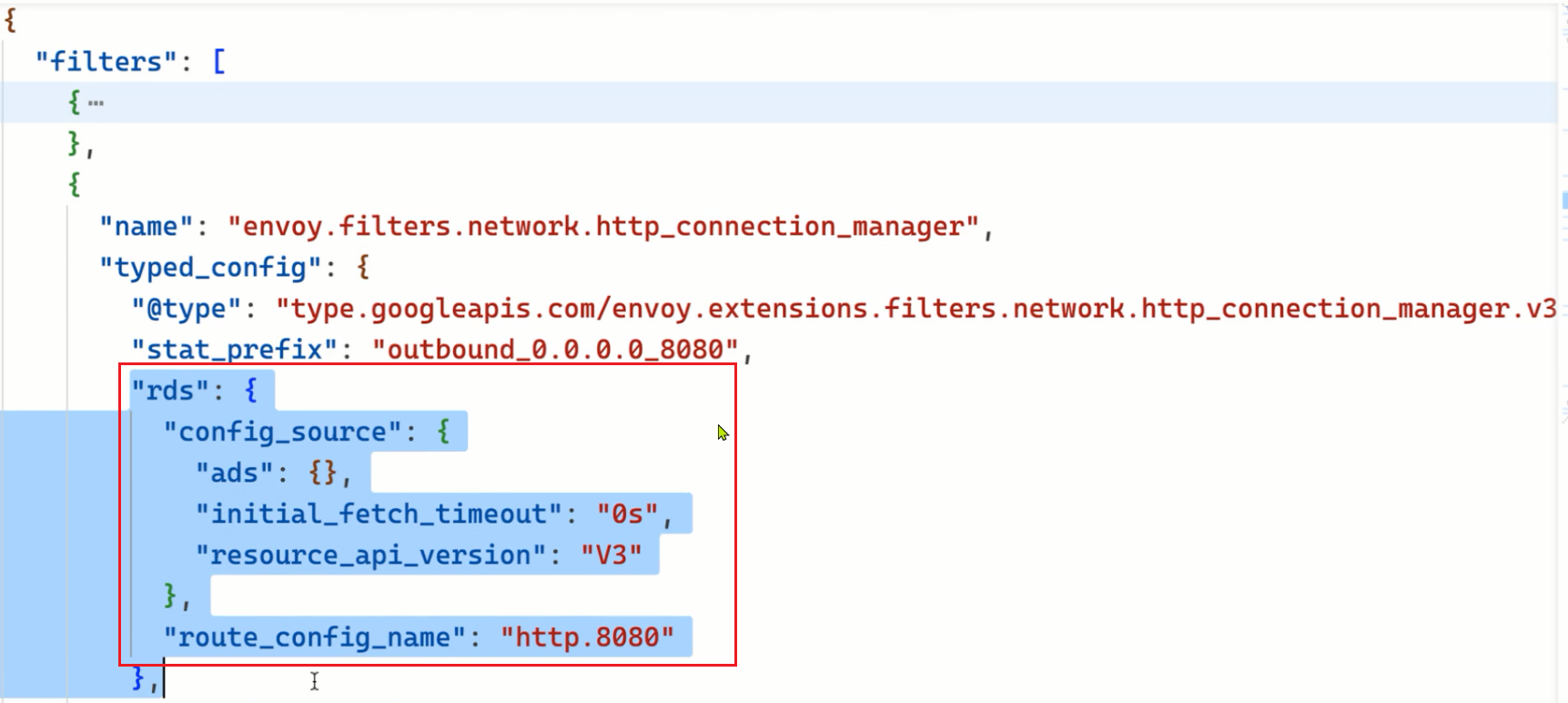
这里面保存着 Envoy 的路由配置,和 listeners 一样,RoutesConfigDump 也分为 static_route_configs 和 dynamic_route_configs,分别对应着静态的路由配置和动态下发的路由配置。
同样我们也可以使用 istioctl proxy-config route 命令来查看这部分配置:
istioctl proxy-config route istio-ingressgateway-9c8b9b586-s6s48 -n istio-system -o yaml
对应的配置如下所示:
- ignorePortInHostMatching: true
maxDirectResponseBodySizeBytes: 1048576
name: http.8080
validateClusters: false
virtualHosts:
- domains:
- "*"
includeRequestAttemptCount: true
name: "*:8080"
routes:
- decorator:
operation: productpage.default.svc.cluster.local:9080/productpage
match:
caseSensitive: true
path: /productpage
metadata:
filterMetadata:
istio:
config: /apis/networking.istio.io/v1alpha3/namespaces/default/virtual-service/bookinfo
route:
cluster: outbound|9080||productpage.default.svc.cluster.local
maxGrpcTimeout: 0s
retryPolicy:
hostSelectionRetryMaxAttempts: "5"
numRetries: 2
retriableStatusCodes:
- 503
retryHostPredicate:
- name: envoy.retry_host_predicates.previous_hosts
typedConfig:
"@type": type.googleapis.com/envoy.extensions.retry.host.previous_hosts.v3.PreviousHostsPredicate
retryOn: connect-failure,refused-stream,unavailable,cancelled,retriable-status-codes
timeout: 0s
- decorator:
operation: productpage.default.svc.cluster.local:9080/static*
match:
caseSensitive: true
prefix: /static
metadata:
filterMetadata:
istio:
config: /apis/networking.istio.io/v1alpha3/namespaces/default/virtual-service/bookinfo
route:
cluster: outbound|9080||productpage.default.svc.cluster.local
maxGrpcTimeout: 0s
retryPolicy:
hostSelectionRetryMaxAttempts: "5"
numRetries: 2
retriableStatusCodes:
- 503
retryHostPredicate:
- name: envoy.retry_host_predicates.previous_hosts
typedConfig:
"@type": type.googleapis.com/envoy.extensions.retry.host.previous_hosts.v3.PreviousHostsPredicate
retryOn: connect-failure,refused-stream,unavailable,cancelled,retriable-status-codes
timeout: 0s
- decorator:
operation: productpage.default.svc.cluster.local:9080/login
match:
caseSensitive: true
path: /login
metadata:
filterMetadata:
istio:
config: /apis/networking.istio.io/v1alpha3/namespaces/default/virtual-service/bookinfo
route:
cluster: outbound|9080||productpage.default.svc.cluster.local
maxGrpcTimeout: 0s
retryPolicy:
hostSelectionRetryMaxAttempts: "5"
numRetries: 2
retriableStatusCodes:
- 503
retryHostPredicate:
- name: envoy.retry_host_predicates.previous_hosts
typedConfig:
"@type": type.googleapis.com/envoy.extensions.retry.host.previous_hosts.v3.PreviousHostsPredicate
retryOn: connect-failure,refused-stream,unavailable,cancelled,retriable-status-codes
timeout: 0s
- decorator:
operation: productpage.default.svc.cluster.local:9080/logout
match:
caseSensitive: true
path: /logout
metadata:
filterMetadata:
istio:
config: /apis/networking.istio.io/v1alpha3/namespaces/default/virtual-service/bookinfo
route:
cluster: outbound|9080||productpage.default.svc.cluster.local
maxGrpcTimeout: 0s
retryPolicy:
hostSelectionRetryMaxAttempts: "5"
numRetries: 2
retriableStatusCodes:
- 503
retryHostPredicate:
- name: envoy.retry_host_predicates.previous_hosts
typedConfig:
"@type": type.googleapis.com/envoy.extensions.retry.host.previous_hosts.v3.PreviousHostsPredicate
retryOn: connect-failure,refused-stream,unavailable,cancelled,retriable-status-codes
timeout: 0s
- decorator:
operation: productpage.default.svc.cluster.local:9080/api/v1/products*
match:
caseSensitive: true
prefix: /api/v1/products
metadata:
filterMetadata:
istio:
config: /apis/networking.istio.io/v1alpha3/namespaces/default/virtual-service/bookinfo
route:
cluster: outbound|9080||productpage.default.svc.cluster.local
maxGrpcTimeout: 0s
retryPolicy:
hostSelectionRetryMaxAttempts: "5"
numRetries: 2
retriableStatusCodes:
- 503
retryHostPredicate:
- name: envoy.retry_host_predicates.previous_hosts
typedConfig:
"@type": type.googleapis.com/envoy.extensions.retry.host.previous_hosts.v3.PreviousHostsPredicate
retryOn: connect-failure,refused-stream,unavailable,cancelled,retriable-status-codes
timeout: 0s
- virtualHosts:
- domains:
- "*"
name: backend
routes:
- match:
prefix: /stats/prometheus
route:
cluster: prometheus_stats
- virtualHosts:
- domains:
- "*"
name: backend
routes:
- match:
prefix: /healthz/ready
route:
cluster: agent
后面的两个 virtualHosts 就是我们的静态路由配置,第一个是动态的路由配置,我们可以看到该配置的名称就是 http.8080,是不是和前面的 routeConfigName 是一致的。那么这个配置又是什么地方定义的呢?
其实仔细看这里面的配置和前面我们创建的 VirtualService 这个资源对象是不是很像,我们再看下前面创建的 VirtualService 对象的定义:
apiVersion: networking.istio.io/v1alpha3
kind: VirtualService
metadata:
name: bookinfo
spec:
hosts:
- "*"
gateways:
- bookinfo-gateway
http:
- match:
- uri:
exact: /productpage
- uri:
prefix: /static
- uri:
exact: /login
- uri:
exact: /logout
- uri:
prefix: /api/v1/products
route:
- destination:
host: productpage
port:
number: 9080
我们可以看到在 VirtualService ��对象中定义了 5 个路由规则,而这里的 RoutesConfigDump 中也定义了 5 个路由规则,VirtualService 中定义的 5 个路由分别为 /productpage、/static、/login、/logout、/api/v1/products,而 RoutesConfigDump 中定义的 5 个路由分别为 /productpage、/static、/login、/logout、/api/v1/products,是不是一一对应的。最终匹配这些路由规则的请求是被转发到 productpage 这个服务的 9080 端口的。
比如 /productpage 这个路由规则对应的 Envoy 配置如下所示:
- domains:
- "*"
includeRequestAttemptCount: true
name: "*:8080"
routes:
- decorator:
operation: productpage.default.svc.cluster.local:9080/productpage
match:
caseSensitive: true
path: /productpage
metadata:
filterMetadata:
istio:
config: /apis/networking.istio.io/v1alpha3/namespaces/default/virtual-service/bookinfo
route:
cluster: outbound|9080||productpage.default.svc.cluster.local
maxGrpcTimeout: 0s
retryPolicy:
hostSelectionRetryMaxAttempts: "5"
numRetries: 2
retriableStatusCodes:
- 503
retryHostPredicate:
- name: envoy.retry_host_predicates.previous_hosts
typedConfig:
"@type": type.googleapis.com/envoy.extensions.retry.host.previous_hosts.v3.PreviousHostsPredicate
retryOn: connect-failure,refused-stream,unavailable,cancelled,retriable-status-codes
timeout: 0s
这个配置就是我们熟悉的 Envoy 的关于虚拟主机部分的配置,比如当我们请求的路径为 /productpage 时,就会被这个路由规则匹配到,然后就用通过 route 字段来描述我们的路由目标了,针对这个目录,可以看到有一些类似于 retry_policy、timeout等字段来配置这个目标的超时、重试策略等,不过最重要的还是 cluster 这个字段,它指定了这个路由目标对应着哪个上游集群,Envoy 最终将请求发送到这个 Cluster,比如我们这里的集群名称为 outbound|9080||productpage.default.svc.cluster.local,关于其具体配置我们就要去查看 ClustersConfigDump 中的配置了。
ClustersConfigDump
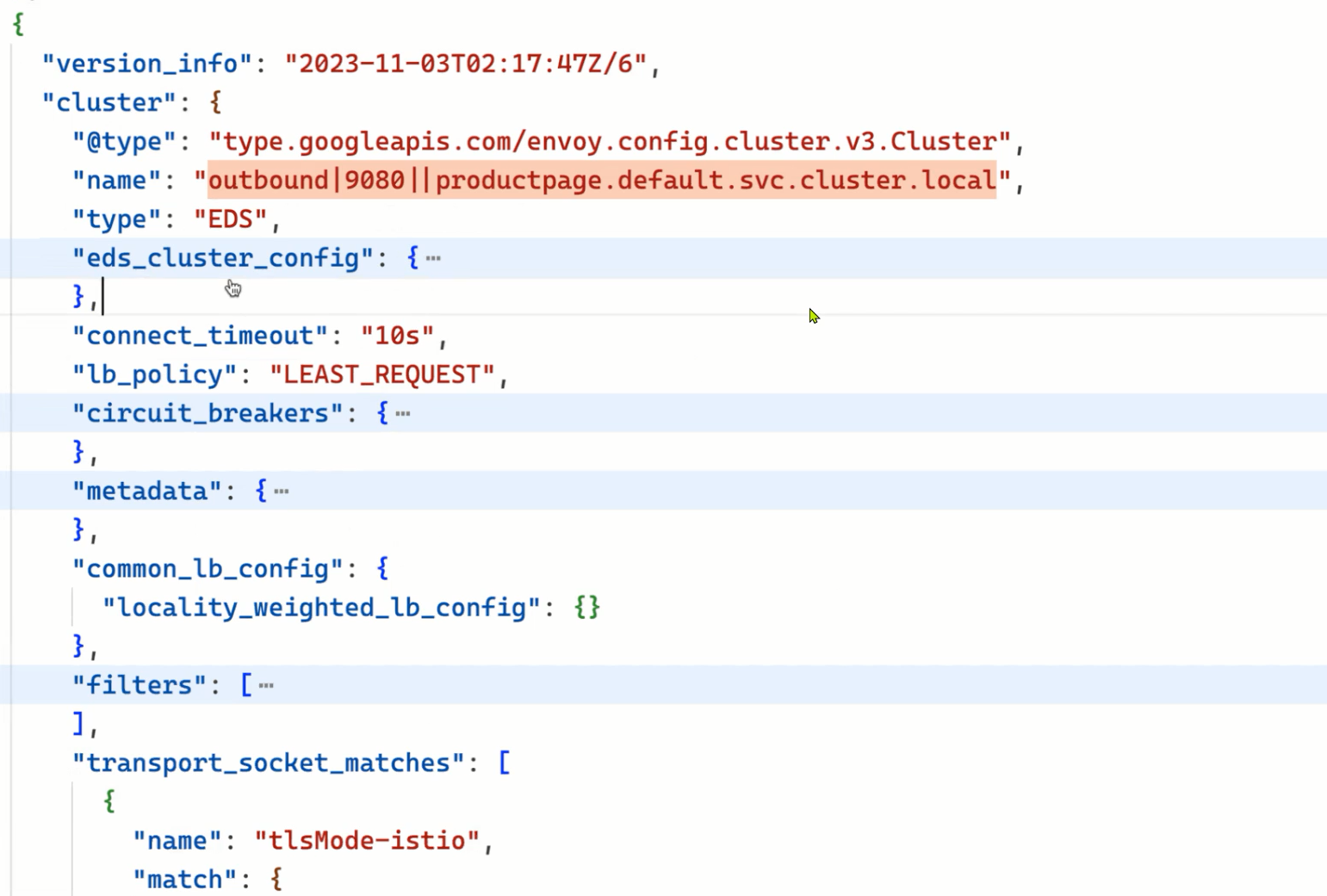
该部分是用来存储 Envoy 的集群配置的,同样也分为 static_clusters 和 dynamic_active_clusters,分别对应着静态配置和动态下发的配置。这里的 Cluster 集群是 Envoy 内部的概念,它是指 Envoy 连接的一组逻辑相同的上游主机,并不是说 K8s 集群,只是大多数情况下我们可以把这个集群理解为 K8s 集群中的一个 Service,一个 Service 通常对应着一组 Pod,由这组 Pod 响应请求并提供同一种服务,而 Envoy 的这个集群实际可以理解成这种Pod 集合。不过 Envoy 的一个集群也不一定就对应着一个 Service,因为集群是一组逻辑相同的上游主机,所以也有可能是别的符合定义的东西,比如说是服务的一个特定版本(如只是 v2 版本的 reviews 服务)。istio 的版本灰度能力就是基于这个做的,因为两个版本的同一服务实际上可以分成两个集群。
同样我们可以使用 istioctl proxy-config cluster 命令来查看这部分配置:
istioctl proxy-config cluster istio-ingressgateway-9c8b9b586-s6s48 -n istio-system -o yaml
该配置文件会非常长,它会将 K8s 集群中的 Service 都转换成 Envoy 的 Cluster,这里我们只看下 productpage 这个服务对应的 Cluster 配置,如下所示:
- circuitBreakers: #
thresholds:
- maxConnections: 4294967295
maxPendingRequests: 4294967295
maxRequests: 4294967295
maxRetries: 4294967295
trackRemaining: true
commonLbConfig:
localityWeightedLbConfig: {}
connectTimeout: 10s
edsClusterConfig:
edsConfig:
ads: {}
initialFetchTimeout: 0s
resourceApiVersion: V3
serviceName: outbound|9080||productpage.default.svc.cluster.local
filters:
- name: istio.metadata_exchange
typedConfig:
"@type": type.googleapis.com/envoy.tcp.metadataexchange.config.MetadataExchange
protocol: istio-peer-exchange
lbPolicy: LEAST_REQUEST
metadata:
filterMetadata:
istio:
services:
- host: productpage.default.svc.cluster.local
name: productpage
namespace: default
name: outbound|9080||productpage.default.svc.cluster.local
transportSocketMatches:
- match:
tlsMode: istio
name: tlsMode-istio
transportSocket:
name: envoy.transport_sockets.tls
typedConfig:
"@type": type.googleapis.com/envoy.extensions.transport_sockets.tls.v3.UpstreamTlsContext
commonTlsContext:
alpnProtocols:
- istio-peer-exchange
- istio
combinedValidationContext:
defaultValidationContext:
matchSubjectAltNames:
- exact: spiffe://cluster.local/ns/default/sa/bookinfo-productpage
validationContextSdsSecretConfig:
name: ROOTCA
sdsConfig:
apiConfigSource:
apiType: GRPC
grpcServices:
- envoyGrpc:
clusterName: sds-grpc
setNodeOnFirstMessageOnly: true
transportApiVersion: V3
initialFetchTimeout: 0s
resourceApiVersion: V3
tlsCertificateSdsSecretConfigs:
- name: default
sdsConfig:
apiConfigSource:
apiType: GRPC
grpcServices:
- envoyGrpc:
clusterName: sds-grpc
setNodeOnFirstMessageOnly: true
transportApiVersion: V3
initialFetchTimeout: 0s
resourceApiVersion: V3
tlsParams:
tlsMaximumProtocolVersion: TLSv1_3
tlsMinimumProtocolVersion: TLSv1_2
sni: outbound_.9080_._.productpage.default.svc.cluster.local
- match: {}
name: tlsMode-disabled
transportSocket:
name: envoy.transport_sockets.raw_buffer
typedConfig:
"@type": type.googleapis.com/envoy.extensions.transport_sockets.raw_buffer.v3.RawBuffer
type: EDS
我们可以看到这个 Envoy Cluster 的名称为 outbound|9080||productpage.default.svc.cluster.local,和前面的路由配置中的 cluster 字段是一致的,名称大多数会由 | 分成四个部分,分别是 inbound 或 outbound 代表入向流量或出向流量、端口号、subcluster 名称(就是对应着 destination rule 里的 subset)、Service FQDN,由 istio 的服务发现进行配置,通过这个 name 我们很容易就能看出来这个集群对应的是 K8s 集群的哪个服务。
然后配置的负载均衡策略是 LEAST_REQUEST,另外比较重要的这里的配置的类型为 type: EDS,也就是会通过 EDS 来发现上游的主机服务,这个 EDS 的配置如下所示:
edsClusterConfig:
edsConfig:
ads: {}
initialFetchTimeout: 0s
resourceApiVersion: V3
serviceName: outbound|9080||productpage.default.svc.cluster.local
基于 EDS 去动态发现上游主机的配置,其实在前面的 Envoy 章节我们已经介绍过了,和这里是不是几乎是一致的,serviceName 其实就对应着 K8s 集�群中的 productpage 这个 Service 对象的 9080 端口,而这个 Service 对象对应着一组 Pod,这组 Pod 就是我们的上游主机了。当然这是通过 xDS 协议下发的,我们可以通过 istioctl proxy-config endpoint 命令来查看这部分配置:
istioctl proxy-config endpoint istio-ingressgateway-9c8b9b586-s6s48 -n istio-system -o yaml
该部分数据非常多,下面只截取 productpage 相关的数据,如下所示:
- addedViaApi: true
circuitBreakers:
thresholds:
- maxConnections: 4294967295
maxPendingRequests: 4294967295
maxRequests: 4294967295
maxRetries: 4294967295
- maxConnections: 1024
maxPendingRequests: 1024
maxRequests: 1024
maxRetries: 3
priority: HIGH
edsServiceName: outbound|9080||productpage.default.svc.cluster.local
hostStatuses:
- address:
socketAddress:
address: 10.244.2.62
portValue: 9080
healthStatus:
edsHealthStatus: HEALTHY
locality: {}
stats:
- name: cx_connect_fail
- name: cx_total
value: "1"
- name: rq_error
- name: rq_success
value: "4"
- name: rq_timeout
- name: rq_total
value: "4"
- name: cx_active
type: GAUGE
- name: rq_active
type: GAUGE
weight: 1
name: outbound|9080||productpage.default.svc.cluster.local
observabilityName: outbound|9080||productpage.default.svc.cluster.local
可以看到上面的配置中就包含一个真正的后端服务地址:
address:
socketAddress:
address: 10.244.2.62
portValue: 9080
这个地址其实就是 productpage 这��个 K8s Service 关联的 Pod 的地址。这样一个请求从进入到 Envoy 到最终转发到后端服务的过程就清楚了。
SecretsConfigDump
由于网格中的 Envoy 之间互相通信会使用 mTLS 模式,因此每个 Envoy 通信时都需要提供本工作负载的证书,同时为了签发证书还需要 istio ca 的根证书,这些证书的信息保存在该配置项之下。
可视化
到这里我们就把 Envoy 的整个配置文件都理解了一遍,它们分别是 Bootstrap、Listeners、Routes、Clusters、Secrets 几个配置,其中又涉及到 VirtualHost 等细分概念。总体来看,一个典型的 HTTP 请求在 Envoy 内部经历了以下事情:
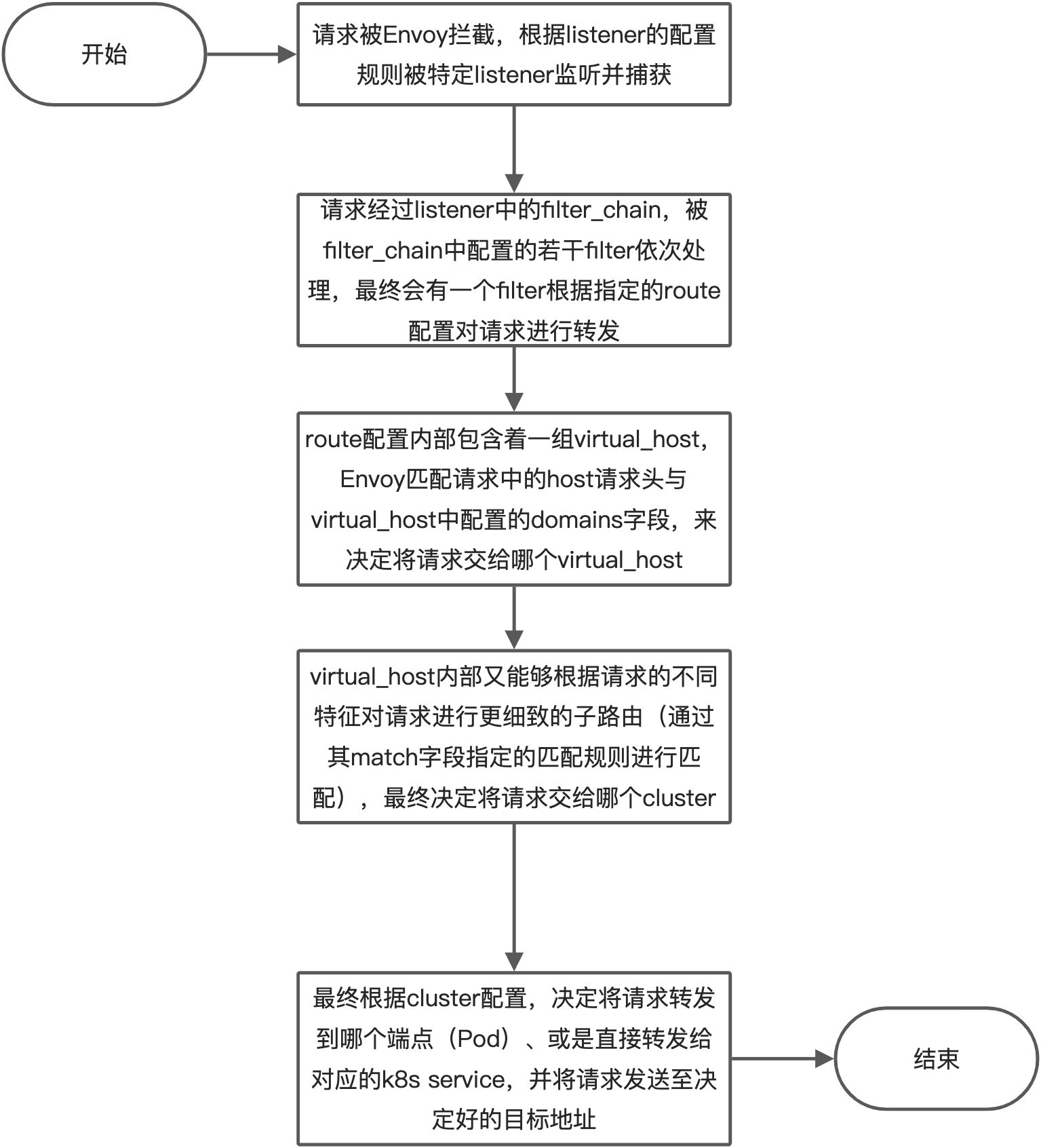
整体上一个请求在 Envoy 内部的处理与转发过程中,listener、route、cluster 这几个配置是环环相扣的,它们通过配置的 name 一层又一层地向下引用(listener 内的 filter 引用 route、route 内的 virtual_host 引用 cluster),形成了一条引用链,最终将请求从 listener 递交到具体的 cluster。
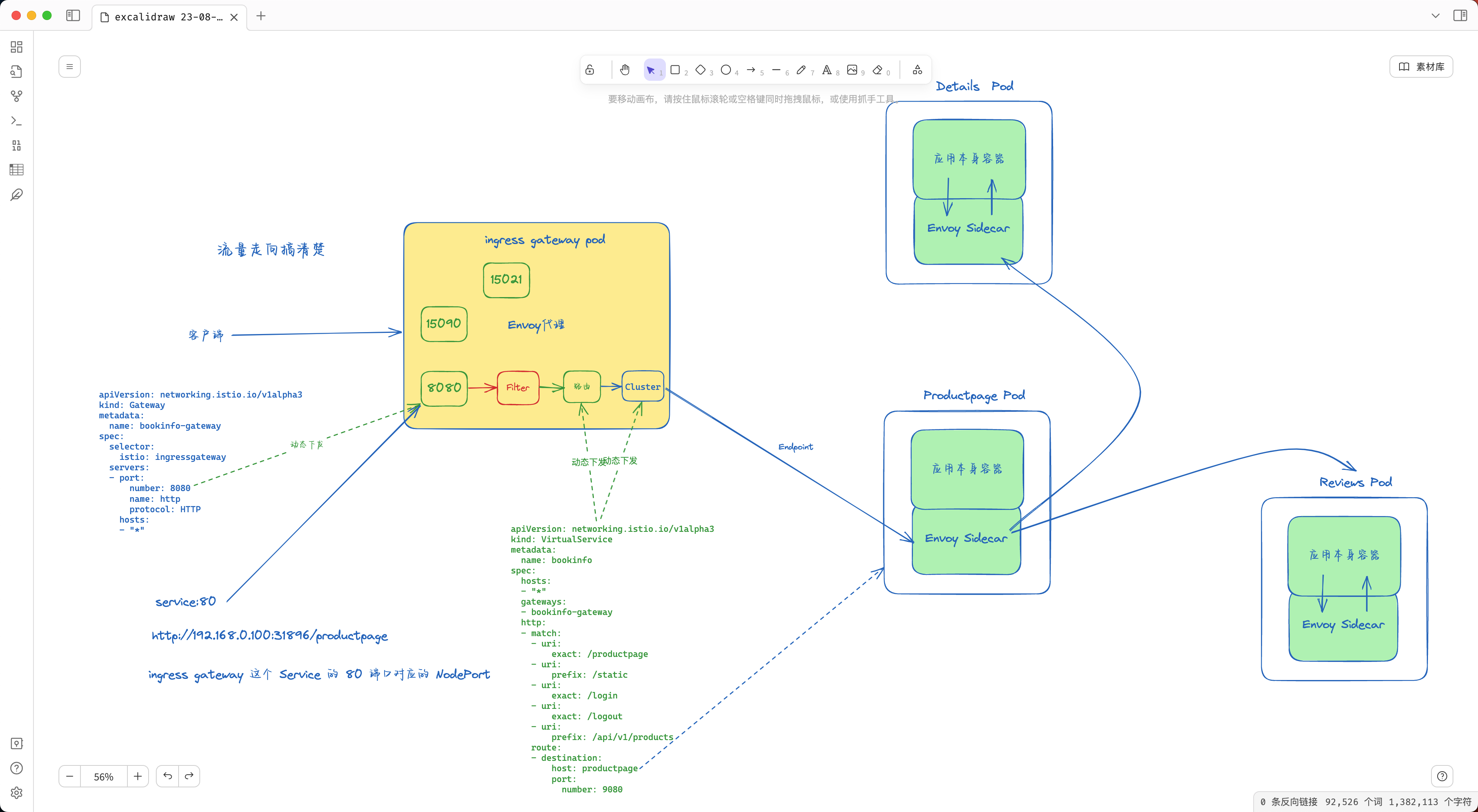
🍀
我们可以使用 envoyui.solo.io 这个在线的 Envoy 配置可视化工具来查看 Envoy 的配置,只需要将我们的 Envoy 配置 dump 出来上传上来即可:
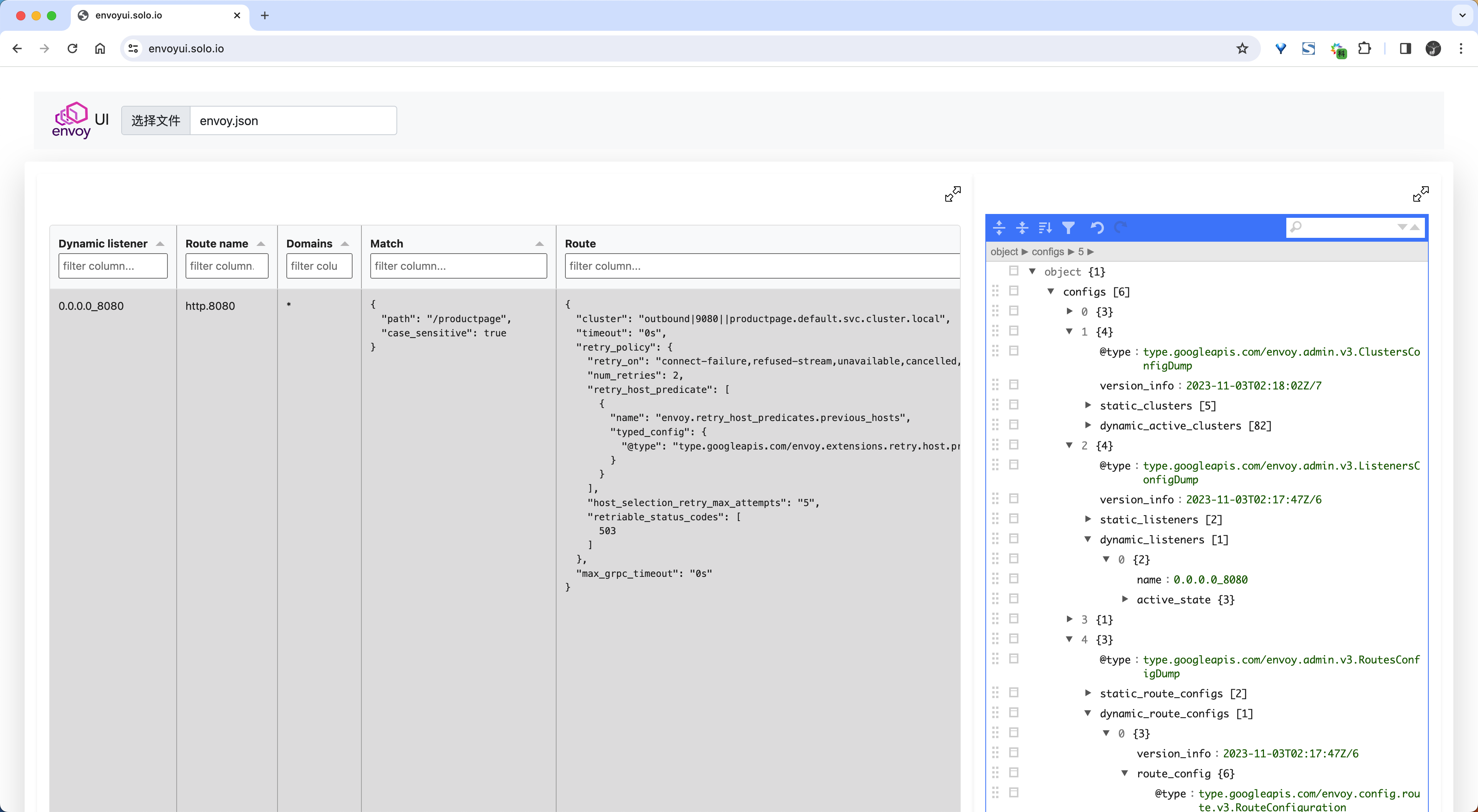
经过上面的分析我们也明白了其实 Istio 并没有实现很多复杂的逻辑,服务治理相关的功能比如负载均衡、故障注入、权重路由等都是 Envoy 本身就有的能力,Istio 只是将这些能力抽象成了一个个资源对象,然后通过 Envoy 的 xDS 协议下发到 Envoy 中,这样就能够实现对 Envoy 的流量治理了。所以重点还是需要我们先理解 Envoy 的配置,然后再去理解 Istio 的配置,这样才能更好的理解 Istio,不然你就不清楚 Gateway、VirtualService 等这些资源对象到底是干什么的,它们是如何影响 Envoy 的配置的。
当然我们这里还只是分析的 Istio Ingress Gateway 的配置,而对于 Sidecar 模式的 Envoy 代理又是如何去配置的呢?它又是如何将 Pod 的流量进行拦截的呢?这些我们后面会继续分析。
自定义一个端口访问应用
==🚩 实战:自定义一个端口访问应用-2023.11.6(测试成功)==
实验环境:
k8s v1.25.4(containerd://1.6.10)
[root@master1 ~]#istioctl version
client version: 1.19.3
control plane version: 1.19.3
data plane version: 1.19.3 (8 proxies)
实验软件:
链接:https://pan.baidu.com/s/1o-GJF88QKWP4WG-FT278Nw?pwd=4pxr
提取码:4pxr
--来自百度网盘超级会员V8的分享
2023.11.6-实战:自定义一个端口访问应用-2023.11.6(测试成功)

实验步骤:
graph LR
A[实战步骤] -->B(1️⃣ 创建Gateway和VirtualService资源)
A[实战步骤] -->C(2️⃣ 创建svc)
A[实战步骤] -->D(3️⃣ 测试)
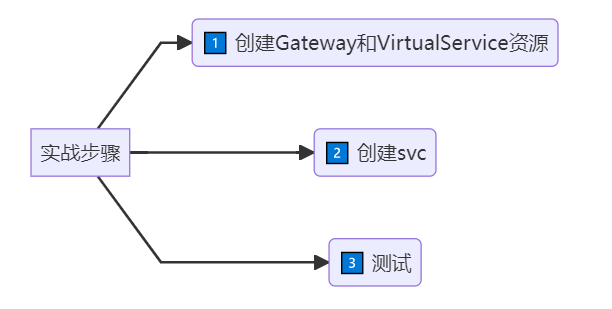
🍀
业务默认端口:

[root@master1 ~]#kubectl get po -nistio-system
NAME READY STATUS RESTARTS AGE
grafana-86b7d46c86-zphx2 1/1 Running 0 20h
istio-egressgateway-8477dd44c4-jgpcg 1/1 Running 0 33h
istio-ingressgateway-5c58fcb646-df7rz 1/1 Running 0 33h
istiod-5d9595449c-8tt97 1/1 Running 0 33h
jaeger-594658fc5b-789s6 1/1 Running 0 20h
kiali-6ff88d695b-2rwtk 1/1 Running 0 20h
prometheus-67599c8d5c-gdhv9 2/2 Running 0 20h
[root@master1 ~]#kubectl get svc -nistio-system
NAME TYPE CLUSTER-IP EXTERNAL-IP PORT(S) AGE
grafana ClusterIP 10.96.218.2 <none> 3000/TCP 20h
istio-egressgateway ClusterIP 10.96.171.120 <none> 80/TCP,443/TCP 33h
istio-ingressgateway LoadBalancer 10.104.174.171 <pending> 15021:32479/TCP,80:31814/TCP,443:31263/TCP,31400:32543/TCP,15443:30806/TCP 33h
istiod ClusterIP 10.110.112.56 <none> 15010/TCP,15012/TCP,443/TCP,15014/TCP 33h
jaeger-collector ClusterIP 10.103.124.73 <none> 14268/TCP,14250/TCP,9411/TCP,4317/TCP,4318/TCP 20h
kiali ClusterIP 10.110.11.151 <none> 20001/TCP,9090/TCP 20h
loki-headless ClusterIP None <none> 3100/TCP 20h
prometheus ClusterIP 10.107.255.204 <none> 9090/TCP 20h
tracing ClusterIP 10.110.109.99 <none> 80/TCP,16685/TCP 20h
zipkin ClusterIP 10.103.145.97 <none> 9411/TCP 20h
我们通过http://172.29.9.61:31814/productpage 来访问
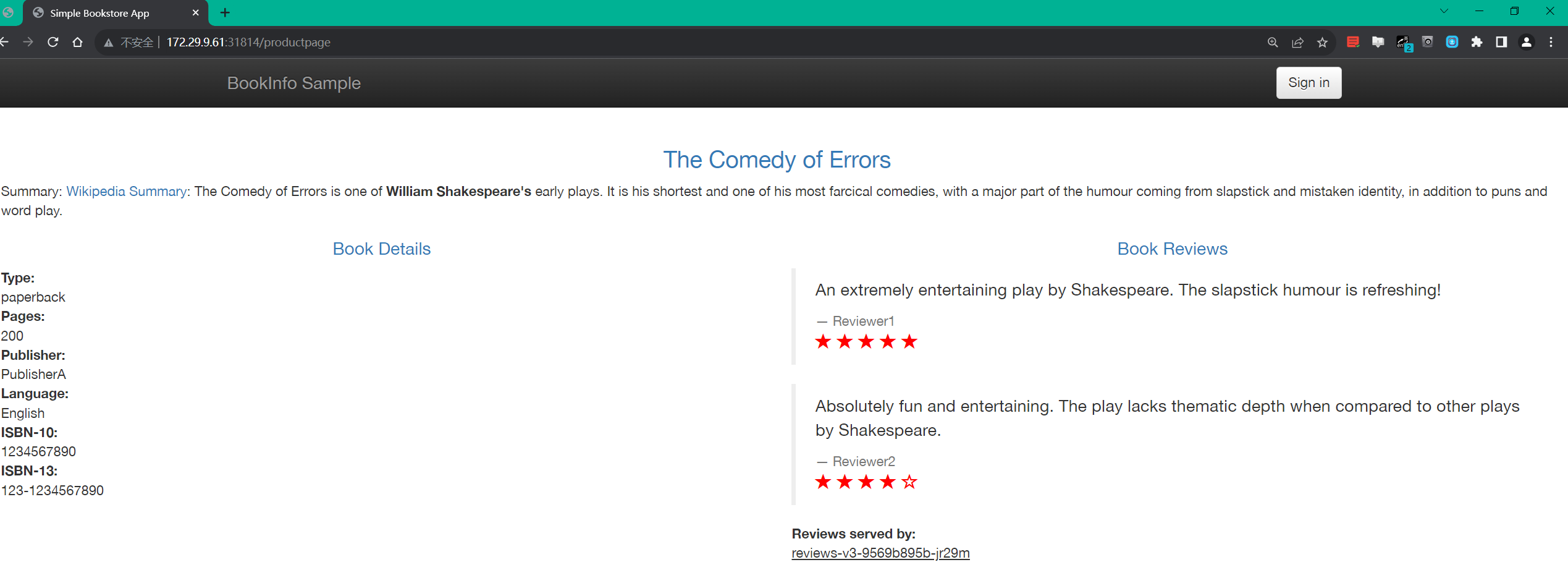
svc:80 --> nodeport
envoy ingress gateway: 8080监听器
[root@master1 istio-1.19.3]#cat samples/bookinfo/networking/bookinfo-gateway.yaml
apiVersion: networking.istio.io/v1alpha3
kind: Gateway
metadata:
name: bookinfo-gateway
spec:
# The selector matches the ingress gateway pod labels.
# If you installed Istio using Helm following the standard documentation, this would be "istio=ingress"
selector:
istio: ingressgateway # use istio default controller
servers:
- port:
number: 8080 #监听器
name: http
protocol: HTTP
hosts:
- "*"
---
apiVersion: networking.istio.io/v1alpha3
kind: VirtualService
metadata:
name: bookinfo
spec:
hosts:
- "*"
gateways:
- bookinfo-gateway
http:
- match:
- uri:
exact: /productpage
- uri:
prefix: /static
- uri:
exact: /login
- uri:
exact: /logout
- uri:
prefix: /api/v1/products
route:
- destination:
host: productpage #svc
port:
number: 9080
[root@master1 istio-1.19.3]#
#svc
apiVersion: v1
33 kind: Service
34 metadata:
35 name: details
36 labels:
37 app: details
38 service: details
39 spec:
40 ports:
41 - port: 9080
42 name: http
43 selector:
44 app: details
#
[root@master1 istio-1.19.3]#kubectl get svc istio-ingressgateway -n istio-system -oyaml
- name: http2
nodePort: 31814
port: 80
protocol: TCP
targetPort: 8080
🍀
现在自己想创建一个新的svc,8088来作为访问应用的入口,该如何配置呢�?
🍀
开始配置
[root@master1 istio-1.19.3]#cp samples/bookinfo/networking/bookinfo-gateway.yaml test-gateway.yaml
[root@master1 istio-1.19.3]#cat test-gateway.yaml
apiVersion: networking.istio.io/v1alpha3
kind: Gateway
metadata:
name: test-gateway
spec:
# The selector matches the ingress gateway pod labels.
# If you installed Istio using Helm following the standard documentation, this would be "istio=ingress"
selector:
istio: ingressgateway # use istio default controller
servers:
- port:
number: 8080
name: http
protocol: HTTP
hosts:
- "*"
---
apiVersion: networking.istio.io/v1alpha3
kind: VirtualService
metadata:
name: test
spec:
hosts:
- "*"
gateways:
- test-gateway
http:
- match:
- uri:
exact: /productpage
- uri:
prefix: /static
- uri:
exact: /login
- uri:
exact: /logout
- uri:
prefix: /api/v1/products
route:
- destination:
host: productpage
port:
number: 9080
---
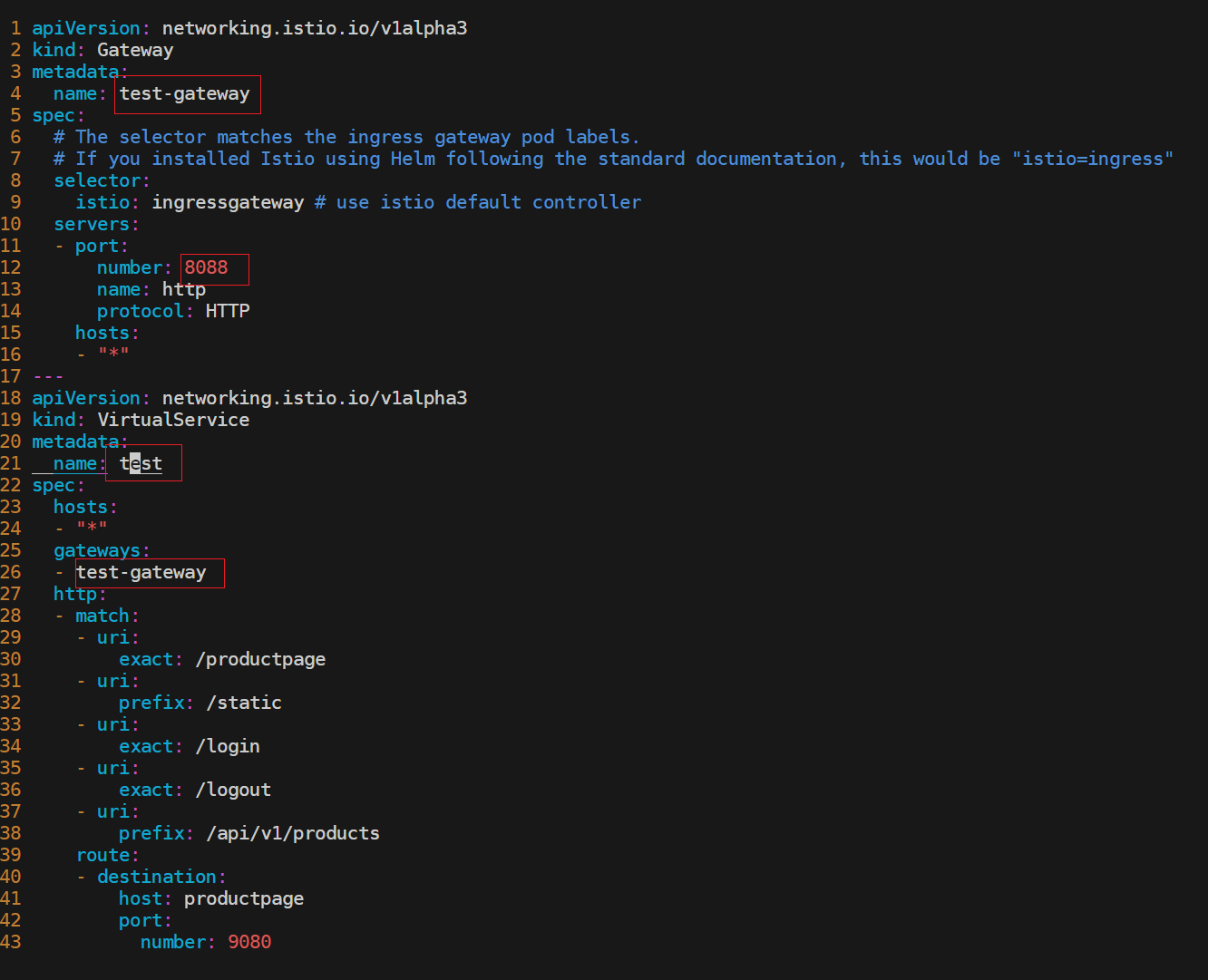
部署:
[root@master1 istio-1.19.3]#kubectl apply -f test-gateway.yaml
gateway.networking.istio.io/test-gateway created
virtualservice.networking.istio.io/test created
可以直接edit这个istio-ingressgateway,或者新创建一个svc也行的。

这里新创建一个svc:
[root@master1 istio-1.19.3]#kubectl apply -f test-gateway.yaml
[root@master1 istio-1.19.3]#cat test-gateway.yaml
apiVersion: v1
kind: Service
metadata:
labels:
app: istio-ingressgateway
install.operator.istio.io/owning-resource: installed-state
install.operator.istio.io/owning-resource-namespace: istio-system
istio: ingressgateway
istio.io/rev: default
operator.istio.io/component: IngressGateways
operator.istio.io/managed: Reconcile
operator.istio.io/version: 1.19.3
release: istio
name: test-gatewy
namespace: istio-system
spec:
ports:
- name: test-port
nodePort: 30080
port: 8088
protocol: TCP
targetPort: 8088
selector:
app: istio-ingressgateway
istio: ingressgateway
type: LoadBalancer
[root@master1 istio-1.19.3]#
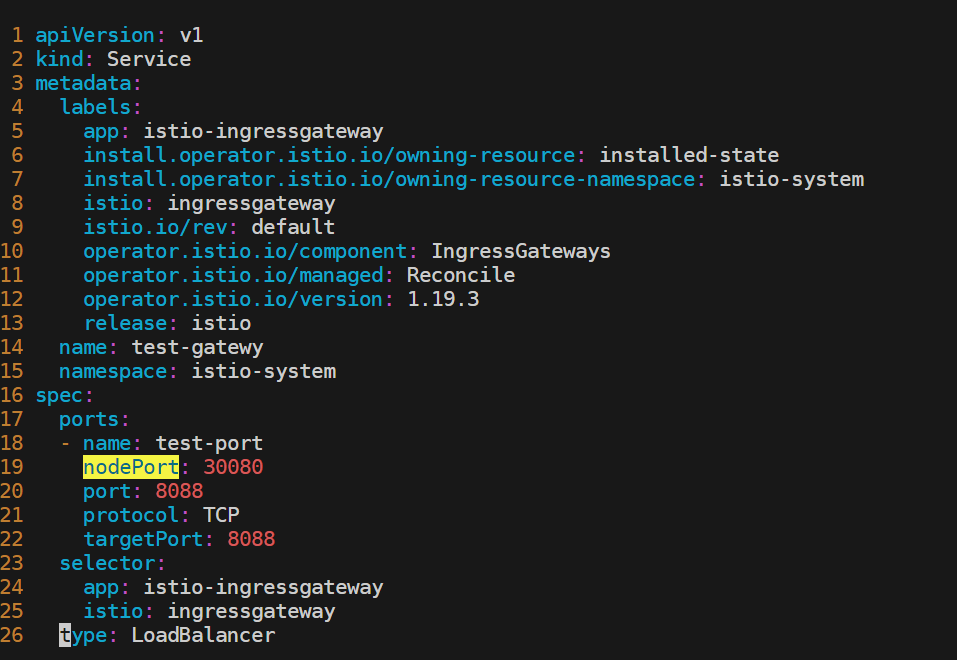
验证:
[root@master1 istio-1.19.3]#kubectl get svc -nistio-system
NAME TYPE CLUSTER-IP EXTERNAL-IP PORT(S) AGE
grafana ClusterIP 10.96.218.2 <none> 3000/TCP 20h
istio-egressgateway ClusterIP 10.96.171.120 <none> 80/TCP,443/TCP 33h
istio-ingressgateway LoadBalancer 10.104.174.171 <pending> 15021:32479/TCP,80:31814/TCP,443:31263/TCP,31400:32543/TCP,15443:30806/TCP 33h
istiod ClusterIP 10.110.112.56 <none> 15010/TCP,15012/TCP,443/TCP,15014/TCP 33h
jaeger-collector ClusterIP 10.103.124.73 <none> 14268/TCP,14250/TCP,9411/TCP,4317/TCP,4318/TCP 20h
kiali ClusterIP 10.110.11.151 <none> 20001/TCP,9090/TCP 20h
loki-headless ClusterIP None <none> 3100/TCP 20h
prometheus ClusterIP 10.107.255.204 <none> 9090/TCP 20h
test-gatewy LoadBalancer 10.101.92.232 <pending> 8088:30080/TCP 42s
tracing ClusterIP 10.110.109.99 <none> 80/TCP,16685/TCP 20h
zipkin ClusterIP 10.103.145.97 <none> 9411/TCP 20h
[root@master1 istio-1.19.3]#
同样也是可以访问的:
http://172.29.9.61:30080/productpage
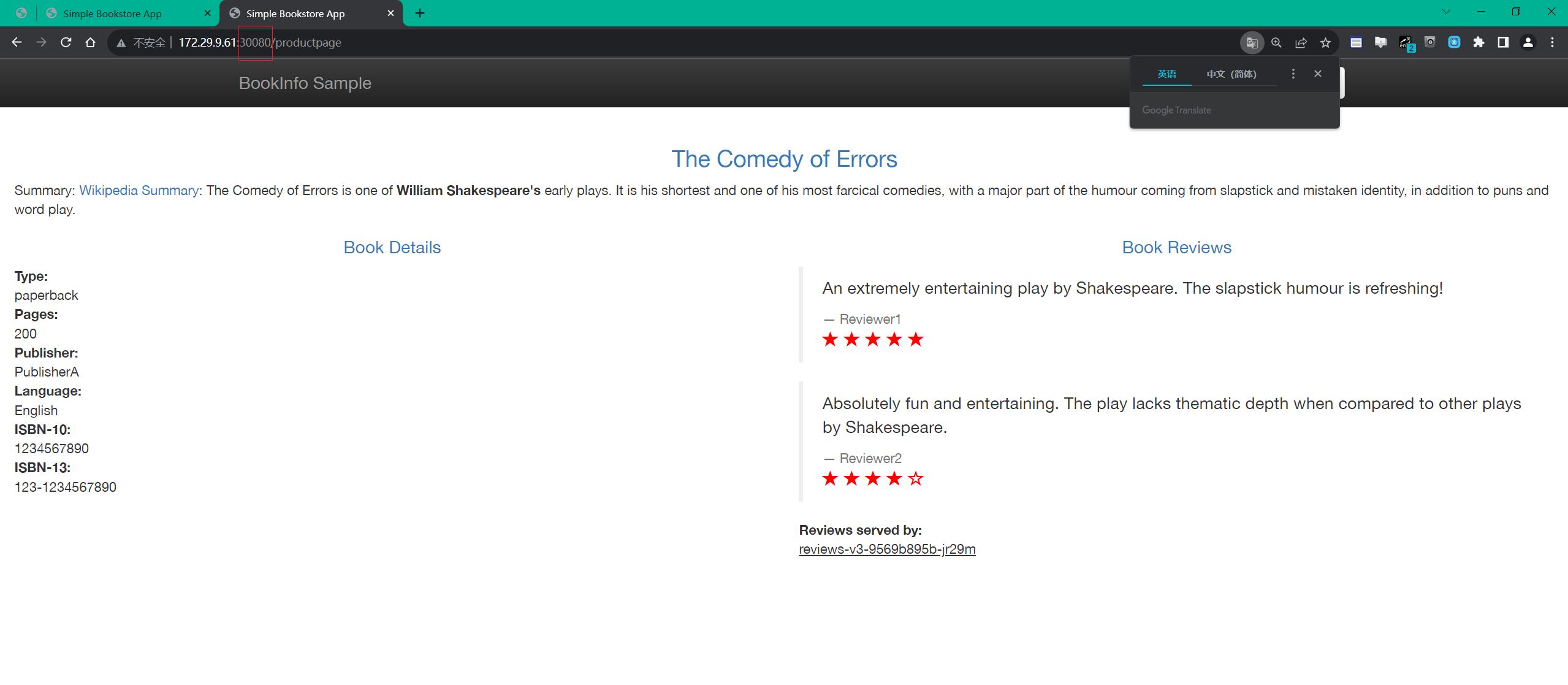
测试结束。😘